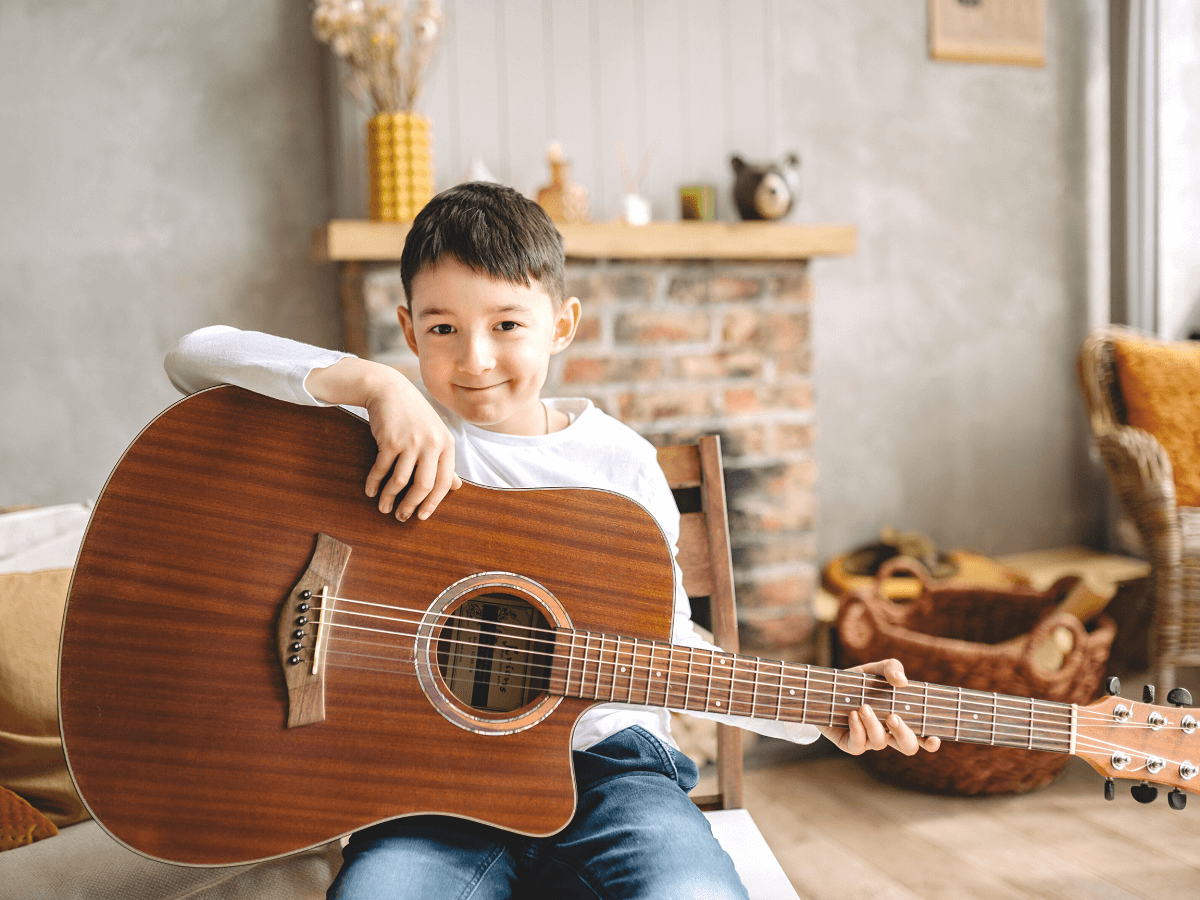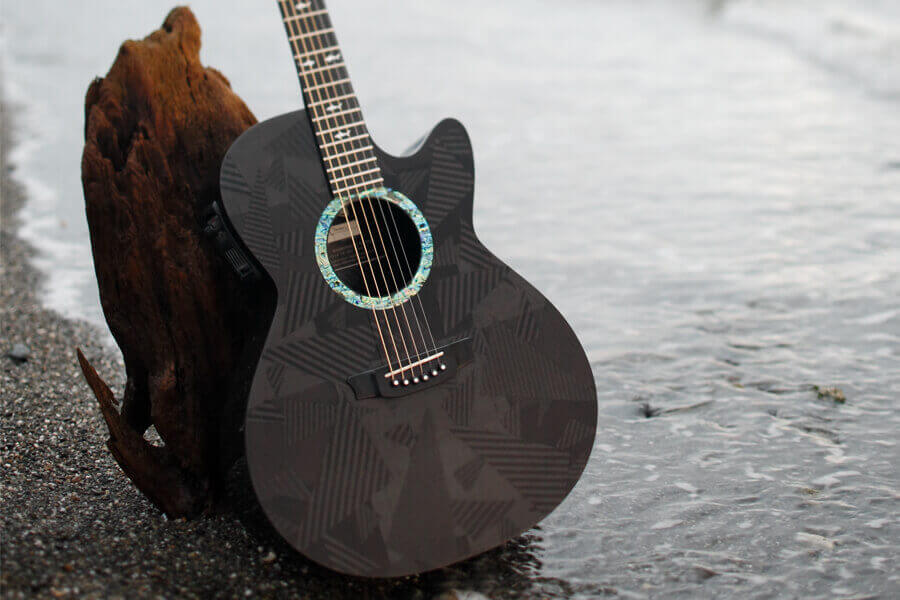Finding the right acoustic guitar for a child can be a daunting task, given the plethora of options available in the market.
The selection is not just about picking the best sounding instrument; it requires consideration of a child’s age, interest, and physical capabilities.
An appropriate guitar can make their learning process enjoyable and lay a strong foundation for their musical aspirations.
This blog provides a comprehensive guide for parents and guardians looking to introduce their children to the world of music through the guitar.
We aim to help you make an informed choice, by reviewing top-rated acoustic guitars suitable for children, based on their quality, size, playability, and price.
Our list includes products from some of the best guitar manufacturers worldwide, ensuring that each guitar strikes the perfect balance between sound quality and ease of holding for young players.
Table of Contents
- Best Acoustic Guitars For Kids That They’ll Love
- Fender CC-60S Concert Acoustic Guitar
- Loog Pro Acoustic Kids Guitar
- Ibanez PN12E Parlor Acoustic Guitar
- Taylor Swift Signature Baby Taylor Acoustic Guitar
- Washburn Apprentice G-Mini Acoustic Guitar
- Hohner 6 String Acoustic Guitar
- Taylor Baby Taylor BT1 Acoustic Guitar
- Martin LX1E Little Martin Acoustic Guitar
- Yamaha Student Series CGS103AII Acoustic Guitar
- Fender Sonoran Mini Acoustic Guitar
- Yamaha APXT2 Acoustic Guitar
- Lyons Classroom Acoustic Guitar
- Fender CP-60S Parlor Acoustic Guitar
- Gretsch G9500 Jim Dandy 24″ Flat Top Acoustic Guitar
- Taylor GS Mini Acoustic Guitar
- Rogue Starter Acoustic Guitar Acoustic Guitar
- Yamaha JR1 FG Junior Acoustic Guitar
- What to Look for When Buying Acoustic Guitars for Kids?
- How to Determine the Right Size of Guitar for Your Child?
- Should You Start with a Nylon or Steel-String Guitar for Your Child?
- How Important Is the Quality of the Guitar for Beginners?
- What to Consider in Terms of the Guitar’s Playability?
- How Vital Is the Sound Quality in a Child’s Guitar?
- How to Maintain and Care for a Kids Acoustic Guitar?
- What Is the Difference Between a Kids Guitar and a Regular Size Guitar?
- Do Kids Outgrow These Guitars Quickly or Will They Last?
- Are There Any Recommended Guitar Education Programs for Kids?
- The Bottom Line
Best Acoustic Guitars For Kids That They’ll Love
Before I begin, here are my top selected choices:
|
|
Yamaha Student Series CGS103AII Acoustic Guitar

Great-sounding, durable Yamaha classical guitar for beginners. Check Price
|
Hohner 6 String Acoustic Guitar

Sturdy, easy-playability travel guitar with warranty.
Check Price
|
Fender CC-60S Concert Acoustic Guitar
Compact, comfortable guitar with articulate voice.
Crafted with a solid spruce top, the guitar combines laminated mahogany back and sides with an easy-to-play mahogany neck for enhanced durability. It’s well-designed for beginners, offering a comfortable concert-sized body that is great for fingerpicking. Its phosphor bronze strings and combination pickup configuration ensure high sound quality, making it ideal for various environments from the beach to a coffeehouse.
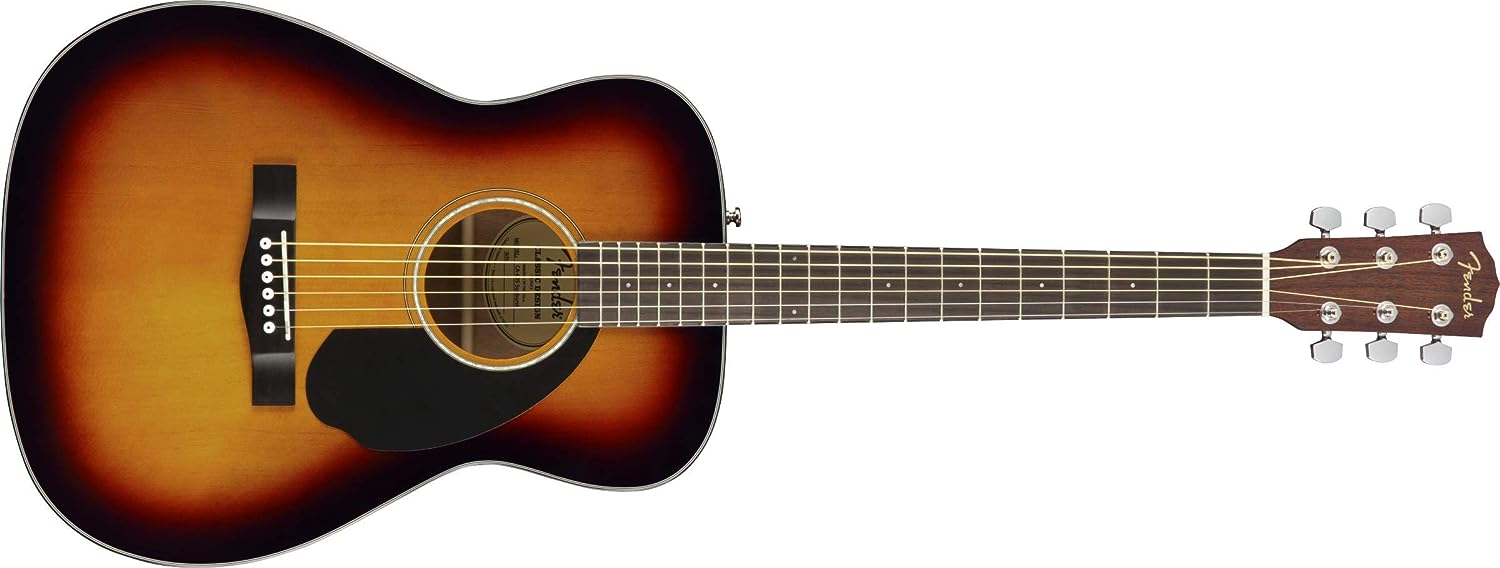
The Fender CC-60S Concert Acoustic Guitar sports a captivating 3-Color Sunburst design.
This guitar stands out with its solid spruce top that adds to the overall sound quality.
The back and sides of this beautiful guitar are made from laminated mahogany, adding another layer of quality to its build.
Creating a comfortable play experience, it features a 25.3″-scale mahogany neck.
Fender has incorporated an ‘Easy-to-Play’ shape and rolled fretboard edges into its design for a smoother playing experience.
Take note, however, the case does not accompany the guitar.
Produced by the renowned brand Fender, this guitar boasts of quality and authenticity.
The guitar’s materials include Mahogany Wood and Spruce Wood for the top and a Mahogany body.
Its back too, is composed of Mahogany Wood while the neck and fretboard are made of the same material for a consistent feel.
The guitar pickup configuration is a combination style, adding versatility to your playing.
The string material is made of phosphor bronze, offering a rich tone.
It’s also worth noting that the guitar is set up for right-hand orientation.
Specially designed for beginner players, the CC-60S offers a compact and comfortable design.
With a smaller, concert-sized body, it’s easy to handle in any playing position and is particularly good for fingerpicking owing to its articulate voice.
Whether chilling on the beach, relaxing on your patio, or playing at the local coffeehouse, the solid spruce top and mahogany back and sides make this guitar a versatile and appealing choice.
- My Review
Upon first glance, the Fender CC-60S Concert Acoustic Guitar immediately caught my attention with its striking 3-color Sunburst aesthetic.
Having spent considerable time playing this guitar, I’m pleased with the exceptional sound it produces, largely attributed to its Solid Spruce Top and Laminated Mahogany Back and Sides.
Bringing to light its material composition, Mahogany takes the leading role, applied to the top material type, body, back, neck, and fretboard.
The combination of Mahogany and Spruce Wood tops adds to the resonant quality of the sound, offering both warm and bright tonal properties.
As I strummed the strings, I observed that the Phosphor Bronze string material enriched the overall sound, adding an ideal pinch of brightness and clarity.
Evaluating the neck, I realized it’s designed using Fender’s ‘Easy-to-Play’ shape with rolled fretboard edges, aptly making it an excellent choice for newbies as well as experienced players.
As someone who is right-handed, I wasn’t impeded due to the guitar’s right hand orientation.
I’ve found that the CC-60S is more compact and comfortable to use, making it a great traveling companion for any gig, street performance, or even a music-filled campfire night.
I also observed that the guitar has a way of holding its tune for extended periods, meaning less time tuning and more time playing.
Unfortunately, the guitar didn’t include a case, which may require a separate purchase for those needing protection during travel or storage.
An area that garnered my attention was the pesky sticker applied to the pick guard which, when removed, could potentially harm the finish.
Apart from these negligible hiccups, the Fender CC-60S Concert Acoustic Guitar truly stands out due to its compactness, comfortable construction, stunning aesthetic, and most importantly, its rich, vibrant sound.
In my candid opinion, this is a versatile guitar that harmonizes quality, affordability, and performance.
Whether you’re a beginner looking for your first guitar, or an experienced player in need of a reliable backup, the Fender CC-60S could undoubtedly be a strong contender in your selection process.
- Pros:
- Great sound quality.
- Well-built and well-finished.
- Stays in tune.
- Cons:
- Problematic sticker on the front.
- Shipping package might be inadequate.
My final verdict is that the Fender CC-60S Concert Acoustic Guitar delivers an impressive performance for a beginner to mid-level guitar.
The solid spruce top and laminated mahogany back and sides contribute to its robust and rich tone.
Its ‘Easy-to-Play’ shape with rolled fretboard edges makes it highly comfortable and ideal for new learners.
However, the fact that a case is not included might be a slight drawback for some.
It’s an excellent choice for anyone looking for a compact, easily maneuverable guitar that doesn’t compromise on sound quality.
Loog Pro Acoustic Kids Guitar
Easier, faster learning with real guitar feel.
This award-winning, kid-friendly guitar boasts a unique 3-string design that facilitates a faster learning process, with immediate results for encouragement. Made from real wood for a perfect intonation, it features a low string action and phosphor bronze strings for a distinct folk sound. The package, suitable for kids 6 years and older, includes chord flashcards, video lessons, and full access to the Loog Guitar app.

The Loog Pro Acoustic Guitar is perfect for children over the age of eight.
It’s award-winning design features just three strings, which allows children to pick it up and start playing right from the very first day.
One of its distinct features is its educational approval. Simply put, if you learn on a Loog, you can easily play any other guitar.
It boasts a real wood construction, featuring a low-string action and steel strings for a beautiful, true-to-life folk guitar sound. The materials used include laminated and solid basswood for the body, a maple neck, and a maple wood fretboard.
As part of the package, the guitar comes with an assortment of learning materials, including flashcards with chord diagrams, access to free video tutorials, and full access to the Loog Guitar app, that is compatible with both iOS and Android.
Even though it’s marketed towards children, the guitar will suit anyone who wishes to learn how to play. This includes children from the age of three, with the Pro version ideal for six-year-olds and above and the Pro VI for nine-year-olds and older.
Despite having just three strings, this doesn’t limit its musical range by any means. Every chord on a standard six-string guitar is composed of three notes, hence you can play any song on the Loog.
- My Review
The Loog Pro Acoustic kids Guitar really makes it accessible for youngsters, who are just venturing into the world of music.
Featuring an exceptionally intuitive design, this acoustic guitar is equipped with 3-string design to facilitate ease of use, which undeniably fosters a quicker learning process.
With this guitar, your kids will have rewarding and motivating music sessions from the very beginning.
Keen attention to details has evidently been invested in manufacturing this kids acoustic guitar, as it is comprised of real wood, contributing to the premium build quality and the impeccable folk sound it generates.
The low string action, perfect intonation, and steel strings amalgamate to deliver a remarkable acoustic experience that your kids will relish.
Included with the guitar are interactive materials, including chord diagrams flashcards and free video lessons.
Having full access to the Loog Guitar application, available for both iOS and Android devices, offers an even more comprehensive learning interface.
Equally laudable is the astute design engineering.
The guitar’s perfect size, combined with ambidextrous hand orientation, accentuates the comfort and manageability for the young players.
Despite its targeted design for kids, even adults will find this Loog guitar suitable for their recreational purpose, if they prefer.
I must confess, the guitar isn’t without its flaws.
The string durability might not live up to the desired expectations, as during my usage, one string fell off without any substantial wear and tear.
This incident was disappointing, and adding salve to the wound was their unresponsive customer service.
Besides this, the sound quality might not impress music veterans, some may even categorize it as a ‘toy’ rather than an instrument.
Another drawback that posed as a significant inconvenience to me was the compatibility limitations of the Loog Guitar application with Amazon Fire tablets.
Yet, the enticing fact remains that your kids can genuinely learn to play chords and any song on this 3-string guitar, initiating a love for music right from their young age.
Notwithstanding some shortcomings, this guitar holds incredible potential to be your child’s creative companion, but be prepared for possible minor hitches.
- Pros:
- Good quality construction and sound.
- Included flashcards, video lessons, and app.
- Perfect for kids, easy to learn.
- Cons:
- App not available on all tablets.
- May go out of tune quickly.
- Customer service may lack responsiveness.
The innovative 3-string design enhances the learning process, making it faster and more enjoyable for kids ages 6 and up.
The inclusion of free video lessons, flashcards, and access to the Loog Guitar App makes it a wholesome package for a budding guitarist.
Moreover, the high-quality wood materials and great sound quality ensures it stands up to professional standards while still being accessible for beginners.
As such, the Loog Pro Acoustic kids Guitar is truly a comprehensive, rewarding, and durable instrument that promotes and nurtures a lasting love for music.
Ibanez PN12E Parlor Acoustic Guitar
Affordable parlor guitar with rich mahogany construction.
Crafted with a mahogany body, top, and sides, the Ibanez acoustic-electric guitar delivers rich sound and performance. The vintage mahogany sunburst design features an Ibanez Under Saddle pickup and AEQ-2T preamp with onboard tuner. It includes chrome die-cast tuners, ivory body binding, and a rosewood fretboard, making it ideal for both intimate and larger performances.
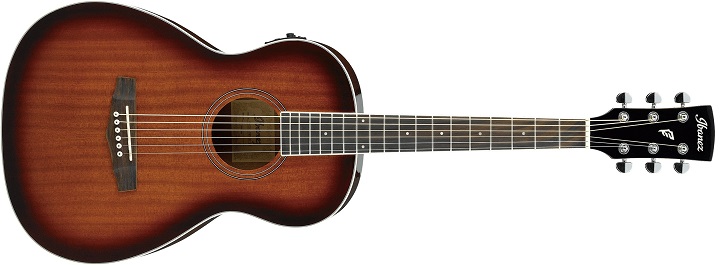
The Ibanez PN12E is an acoustic-electric guitar crafted with a mahogany body, giving it a unique vintage look with its mahogany sunburst color.
Its specific parlor shape and X-bracing makes it distinct from other guitars of the PF Performance Series.
All aspects of the guitar, including top, back, and sides are built from mahogany, an attribute that enhances its overall performance and sound quality.
Unlike its body, the neck of the guitar is built from Maple while its fretboard is composed of a tasteful rosewood.
The instrument is also configured with a Saddle Piezo pickup, which, coupled with an onboard tuner and 1/4″ output, is part of the AEQ-2T preamp setup by Ibanez.
This setup notably aids in performances that require less intimate sounds.
Further elements such as chrome die-cast tuners, Ibanez Advantage bridge pins, and ivory body binding give the guitar an unmatched appeal.
It is completed with a high gloss finish in the shade of vintage mahogany sunburst that enhances its overall vintage appearance.
Additionally, the use of bronze strings and the provision of right hand orientation reaffirms the thoughtfulness in its design and construction to fit the needs of the user.
- My Review
Upon the initial impression, the Ibanez PN12E Mahogany Parlor Acoustic-Electric Guitar lives up to its reputable brand name.
With a vintage mahogany sunburst finish, it is quite a sight to behold and would make a lovely addition to any musician’s collection.
Being composed entirely of high-quality mahogany, not only on the surface but also for the back, sides and neck, the warmth and fullness of this guitar’s sound is undeniably rich.
Although the fretboard is made of rosewood instead of mahogany, this hardly detracts from its quality, further complementing the mahogany body and bringing a balanced tone.
The parlor body shape of the guitar, combined with its X bracing, allows for a delightful resonance.
As a bonus, including the Ibanez Under Saddle pickup and Ibanez AEQ-2T preamp with an onboard tuner and 1/4″ output makes it a suitable instrument for intimate acoustic sessions and louder, electric performances.
However, the guitar has some areas where it falls short.
It seems there might be some consistency issues in production, with the fret finishing varying from smooth to sharp amongst different models.
While these are relatively minor issues, they can impact the playing experience and might require additional expense to correct.
Additionally, reports of parts coming loose, like the nut, is a valid concern that calls into question the level of craftsmanship and quality control in manufacturing.
Although the process is straightforward enough, it is certainly inconvenient and quite disappointing when you consider that these issues are occurring within a short timeline of light usage.
On the other hand, the portability and ease of handling made possible by its size is a rather appealing feature of the PN12E.
Due to its smaller body, it’s perfect for those who travel frequently or prefer a lighter instrument.
Thus, while the Ibanez PN12E Mahogany Parlor Acoustic-Electric Guitar shows immense potential with its beautiful design and promising features, it unfortunately falls short in certain areas of durability and quality control.
Nonetheless, provided these issues can be resolved, it is definitely a worthwhile addition to a guitarist’s collection, especially considering its reasonable price point.
- Pros:
- Excellent sound quality.
- Perfect for beginners.
- Great aesthetic appeal.
- Cons:
- Questionable material durability.
- Unfinished sharp frets.
- Potential delivery damages.
My final verdict is that the Ibanez PN12E Mahogany Parlor Acoustic-Electric Guitar Vintage Mahogany Sunburst is a well-rounded instrument.
The guitar, being made almost entirely of Mahogany, offers a warm and resonating tonal character, perfect for various genres of music.
Its Under Saddle pickup and Ibanez AEQ-2T preamp offer a wide range of sound modification and adaptability for live performances, making it very versatile.
The vintage mahogany sunburst high gloss finish is incredibly aesthetically pleasing, thus adding to the overall appeal of the guitar.
For its affordable price point, it offers excellent value for money and is a strong contender in the parlor guitar category.
Taylor Swift Signature Baby Taylor Acoustic Guitar
Compact, high-quality guitar ideal for on-the-go music.
The Taylor Swift Signature Baby Taylor guitar is a 3/4 size Dreadnought with a slim neck and compact shape, making it a perfect starter or travel guitar. It features top-quality materials including a solid Sitka Spruce top, Layered Sapele back and sides, and African Ebony fingerboard. Loved by Swift herself, this guitar’s design makes it less sensitive to temperature changes, a desirable feature for touring artists.
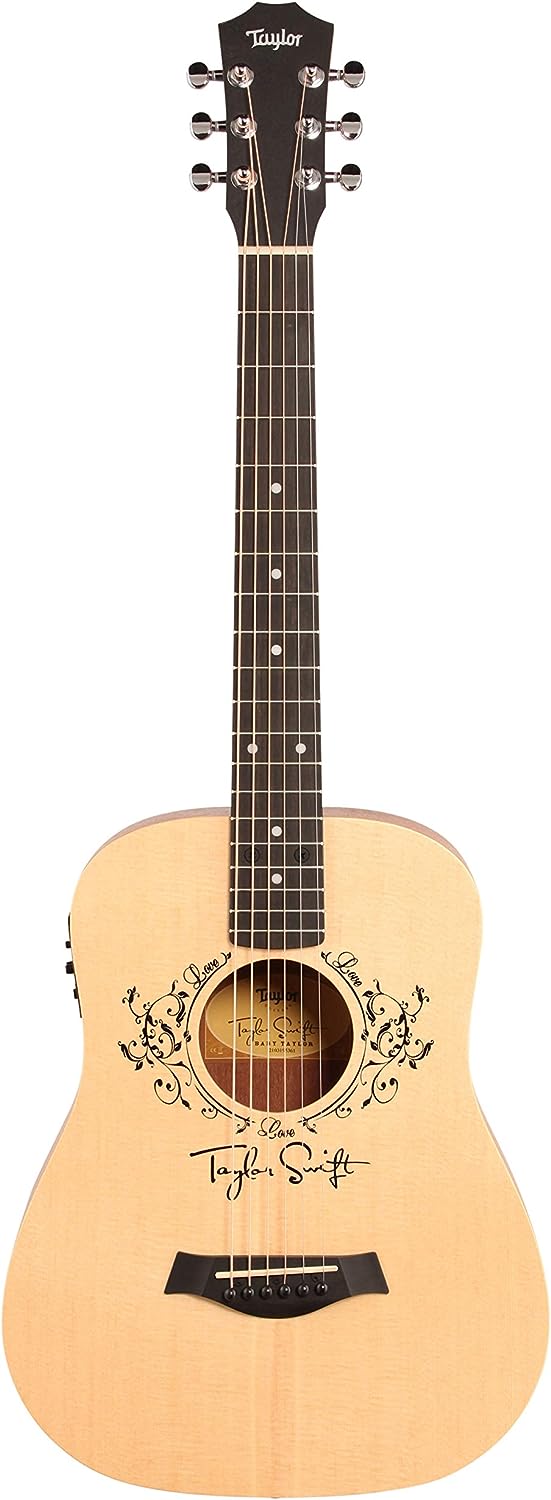
The Taylor Swift Signature Baby Taylor Acoustic-Electric Guitar is carefully crafted with a Dreadnought 3/4th-Scale body type.
Missing a cutaway, its top is composed of Solid Sitka Spruce while the back and sides are made up of Layered Sapele.
The guitar boasts of a Taylor Standard Baby X-Bracing pattern and a Matte 2.0 finish, making it a right-handed model.
Its neck adopts a Taylor Standard Baby Profile shape and is furnished with a genuine African Ebony Fingerboard.
The neck, made from Sapele wood, measures 22-3/4″ in scale length and utilizes 19 frets.
It has a Matte 2.0 Neck finish and extends a special appeal to younger learners and those who find pleasure in playing music on the move, due to its slim 1-11/16″ neck and compact shape.
The three-quarter-size Dreadnought has been a trusted musical partner for touring artists like Taylor Swift, who used it to jot down new musical thoughts while on the road.
Swift fondly used a smaller Baby Taylor as her between-gigs instrument during her initial touring days.
The guitar, in its charming baby size, is not only preferred by Swift but also by travelers who take inspiration from music while exploring the world.
- My Review
As an avid guitar player, I found the Taylor Swift Signature Baby Taylor Acoustic-Electric Guitar appealing and substantial.
The compact shape and the slim neck of this instrument enhance the comfort of play, making it a great choice for both new learners and experienced hands who love to immerse themselves in their music on the road.
Talk about portability, its three-quarter-size Dreadnought fits the bill for musicians who are constantly on the go and need a reliable musical partner.
Made by Taylor, a well-respected brand in the industry, the guitar lives up to the quality and sound that the company is known for.
Moving on, I was particularly drawn by the rich sound this instrument produces, a big part of which can be attributed to the top wood which is made of solid Sitka Spruce, known for its broad dynamic range with crisp articulation.
The combination of a solid top and layered sapele back and sides came across as an excellent choice as it resisted changes in temperature and humidity besides improving the guitar’s sound projection.
Also, it’s worth noting that the layered sapele used for the body material and back material doesn’t just serve a technical purpose, it also gives the guitar its attractive, natural color.
While I absolutely loved the tonal quality produced by this guitar, I did encounter an issue with it staying in tune
Notwithstanding the built-in tuner, tuning this Taylor-made guitar can take a bit of effort which, as a daily player, I found frustrating.
However, this minor setback does not overshadow the great aspects the Taylor Swift Signature Baby Taylor Acoustic-Electric Guitar brings to the table, such as its quality sound, compact size, portable design, and significant material construction.
Speaking from experience, this guitar truly provides an enjoyable playing experience, making it quite a valuable asset, particularly for those constantly on the go or someone who is starting their musical journey.
- Pros:
- Great sound and quality
- Right sized for beginners
- Can be hooked to amp
- Cons:
- Could have tuning issues
- Advertised as acoustic-electric (misleading)
- May be pricey for some
My final verdict is that the Taylor Swift Signature Baby Taylor Acoustic-Electric Guitar Natural is an excellent musical instrument.
Its compact size makes it perfect for young players and those on the go.
The quality and durability of the materials used, including the solid Sitka Spruce top, ensure a prolonged lifespan and great sound.
Whether you’re a budding musician or a seasoned pro, this guitar’s versatility and performance have wide-ranging appeal.
It is a highly recommendable guitar for anyone interested in quality, comfort, and excellent sound.
Washburn Apprentice G-Mini Acoustic Guitar
Compact, affordable guitar with powerful tone and comfort.
The Washburn Apprentice G-Mini 5 is an acoustic guitar crafted with a spruce top and mahogany back and sides for rich, full tone. Designed for comfort and convenience, it’s travel-sized and includes a gig bag, perfectly suited for beginners or mobile musicians. This affordable guitar stands out for its quality, craftsmanship and superior tone.
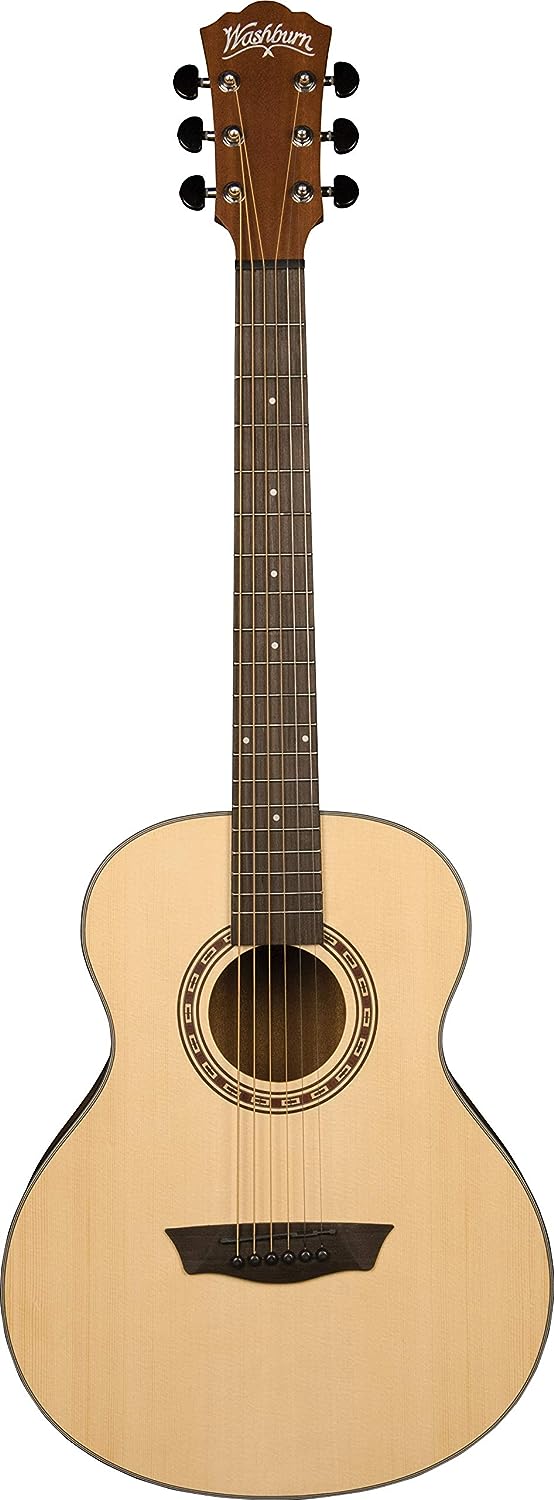
Meet the Washburn Apprentice G-Mini 5, a natural-colored acoustic guitar that is as versatile as it is beautifully crafted.
This nifty companion is not just for beginners aiming to learn and grow, but also serves the needs of experienced musicians needing a travel-friendly instrument.
With the essence of a superior guitar, this 7/8th sized instrument is easy to handle and packs a lot of sounds.
Its grand auditorium shape and size have been explicitly designed for tone, resonance, and comfort during travel gigs.
The top of the guitar boasts a select spruce material that offers full rich tones with fantastic resonance.
The back and sides, made of mahogany, compliments the spruce top, thus enhancing the lower tones of the instrument.
Brand wise, this is a product of Washburn, a well-respected name in the music world, known for its quality, craftsmanship, and innovation.
This guitar package includes a gig bag, making it travel-ready for guitar lessons or even an unplanned jam session with friends.
The Washburn Apprentice G-Mini 5 proves to be a reliable all-rounder catering for different musical needs while promoting comfort, sound quality, and convenience.
So, be it for your office, beach, or road travels, this guitar makes for an excellent musical companion.
- My Review
Upon first impression, the Washburn Apprentice G-Mini 5 is crafted with an artful blend of a spruce top and mahogany sides, giving it a very appealing appearance.
It is not just appealing visually; it is also easy to handle and provides a comfortable grip, making it amicable for players just starting their musical journey, or those experienced players who are always on the go.
The natural color of the guitar, combined with its aesthetically pleasing grand auditorium shape, instantly appeals to any music enthusiast.
One can’t ignore this instrument’s striking quality of sound, mainly because of the select spruce top, which provides a full rich tone, and mahogany sides and back, which resonate more with the lower tones.
The guitar has taken a simplified approach by sticking to the essence of what an acoustic guitar should be, something that I greatly appreciate.
It’s not daunting or overwhelming with an array of unnecessary frills, focusing purely on creating a satisfying acoustic experience.
It’s smaller than a standard guitar, making it easier to handle, especially if you struggle with a larger instrument like I do.
First-time players in particular will find this feature attractive, as it makes the guitar less intimidating and easier to learn on.
Each chord comes out perfectly thanks to the quality bronze strings and mahogany neck fitted with an engineered wood fretboard.
This makes for an excellent sound, and I found the guitar responded well to different playing styles and techniques.
A bonus is the gig bag included with it, which is well padded, providing a cushion for the guitar during travels.
However, it’s worth mentioning that while soundwise the guitar is almost flawless, there was a slight buzzing on the low E string in my testing.
A minor flaw that can most likely be rectified with a simple adjustment!
On a final note, I was pleased with the experience overall, the Washburn Apprentice G-Mini 5 presents excellent value for the price and surprisingly high levels of quality and sound output.
Well suited for both beginners and more seasoned players looking for a reliable and portable instrument, I have no hesitation in recommending it to anyone.
- Pros:
- Perfect for beginners and pros.
- Produces full rich tone.
- Comfortable and convenient size.
- Cons:
- Made in China.
- Not solid spruce top.
- Possible buzzing with low E.
My final verdict is that the Washburn Apprentice G-Mini 5 is a remarkable choice for both beginners and seasoned players.
Its high-quality build from top-quality materials ensures durability, while the size makes it incredibly comfortable to play.
The guitar’s great tonal quality and the affordability factor truly set it apart.
The inclusion of a gig bag makes it perfect for musicians on the go.
It’s a value-for-money guitar that does not compromise on quality or sound.
Hohner 6 String Acoustic Guitar
Sturdy, easy-playability travel guitar with warranty.
This portable, right-handed guitar is half the size of a typical classical one, with a sturdy build for easy playability. Made of agathis wood with a mahogany neck and hardwood fretboard, it ensures quality sound production. It comes with a one-year warranty and uses nylon strings for a smoother strum.
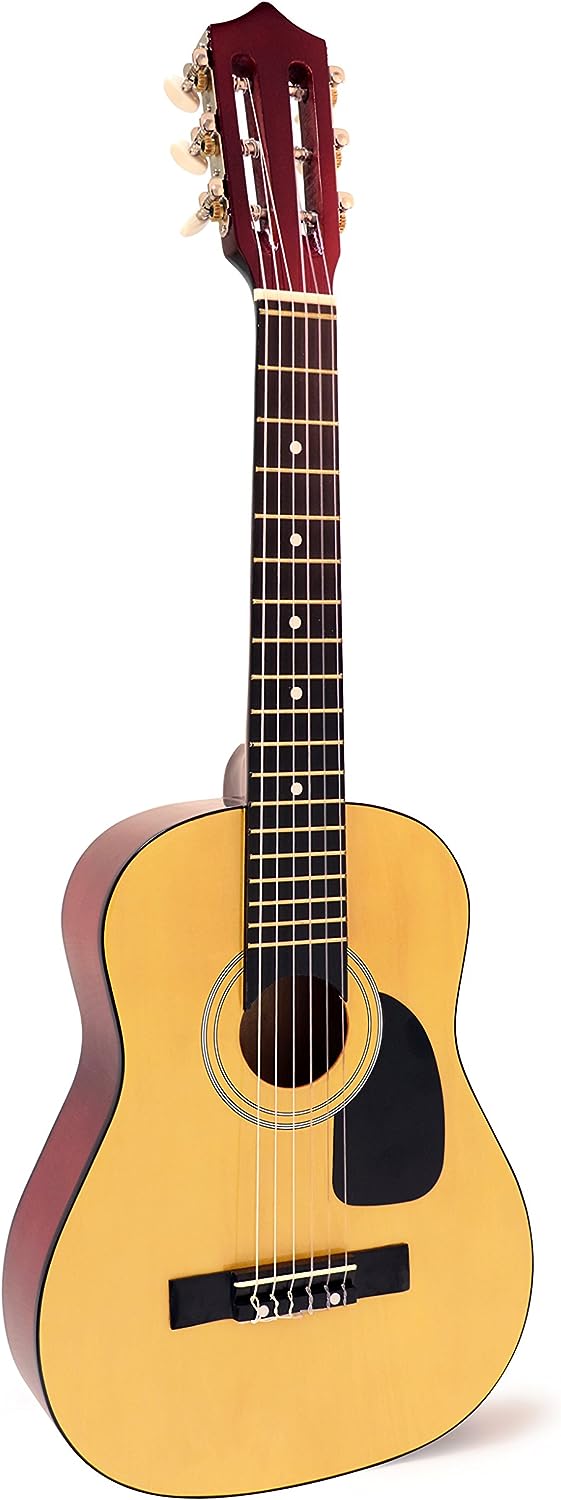
If you’re looking for a robustly built instrument, the HOHNER 6-string acoustic guitar has exactly that, with noteworthy ease of playability made possible by the nylon strings.
Its design is characterized by a half-sized classical structure that makes it an ideal pick if you love travelling with your guitar.
Besides, there’s a reassuring one-year warranty that backs the product.
The guitar sports a natural color that adds to its aesthetic appeal while its construction incorporates Agathis wood for the top, body, and back materials.
Further enhancing the build quality is a neck made from mahogany and a hardwood fingerboard.
There are some additional features like the ‘H’ design for the guitar pickup configuration and the right hand orientation.
This guitar by HOHNER is specially crafted having in mind those who like to take their music with them.
The HAG-250P model is made up of an Agathis body, a mahogany neck and a select hardwood on the fingerboard, completed by an elegant black ivoroid binding.
With its in-line chrome tuners with pearloid keys, it is definitely the go-to guitar for those spur-of-the-moment jam sessions. Note that the case is sold separately.
- My Review
Upon examining the HOHNER 6 String Acoustic Guitar, I noticed that the sturdy build of this instrument immediately stood out.
It boasts a robust agathis wood body, which gives it a natural color and a classic look, not to mention a mahogany neck that enhances its traditional appeal.
What caught my attention about this instrument was the inclusion of nylon strings, as opposed to the more common steel strings used in many guitars.
Nylon strings are typically easier on the fingers, especially for beginner players, and they offer a distinct, softer sound compared to steel strings.
Now, despite its affordable price tag, this guitar is no mere toy or display piece.
It’s indeed a 1/2-sized classical guitar, which makes it perfect for traveling musicians or anyone desiring a more compact instrument.
However, it is worthwhile to note that due to its size, it may be better suited for younger players or adults with smaller hands.
When it comes to performance, this HOHNER guitar does an admirable job.
It produces a rich tone, slightly mellow and sweet as you might expect from a classical guitar, yet it still manages to hold its own in terms of volume.
Adjusting the tuning was quite a task, as the guitar seemed a little resistant to holding its tune initially.
But, as with most new strings, they tended to stretch and will eventually stabilize after some play.
That’s the nature of nylon strings, and I must say, once tuned properly, the guitar delivered a satisfactory sound quality.
The guitar features a hardwood fretboard, which I found to be smooth and easy for moving my fingers across.
Also, the guitar comes with a H guitar pickup configuration, which showcases its versatility and expands the range of sounds I can experiment with.
Despite a few minor noticeable flaws in the finish, the guitar is pretty solidly built.
It feels like it was designed to endure constant use and likely even a few knocks and falls, which is an extremely positive attribute for any acoustic guitar.
Certainly, it may lack the ultra-refined features of higher-end models, but considering its price, it gives amazing value.
In my opinion, this HOHNER 6 String Acoustic Guitar is a reliable and user-friendly instrument that offers a great playing experience for music enthusiasts of different skill levels.
It’s indeed a charming little guitar that invites you to pick it up and enjoy playing.
- Pros:
- Durable, good for children use.
- Decent sound for the size.
- Comfortable for smaller hands.
- Cons:
- Difficulties maintaining tune.
- Build quality is basic.
- Sound doesn’t project well.
My final verdict is that the HOHNER 6 String Acoustic Guitar is a commendable traveling companion for any guitar enthusiast.
It offers sturdy build quality and easy playability, thanks to its Nylon strings.
The guitar is also appealing because of its agathis body and mahogany neck materials, ensuring long-lasting durability.
Moreover, it captivates with its 1/2 classical size, making it perfect for musicians on the go.
However, keep in mind the case is sold separately, but regardless, this instrument provides excellent value for its price and offers a 1-year warranty.
Taylor Baby Taylor BT1 Acoustic Guitar
Left-handed Taylor guitar with sweet walnut tone.
This left-handed acoustic guitar boasts a spruce top with a natural finish, complemented by an ebony fingerboard and sturdy walnut back and sides. The maple neck and phosphor bronze strings ensure lasting sound quality and durability. Manufactured by Taylor, its construction offers a unique and sweet tone, making it ideal for music enthusiasts.
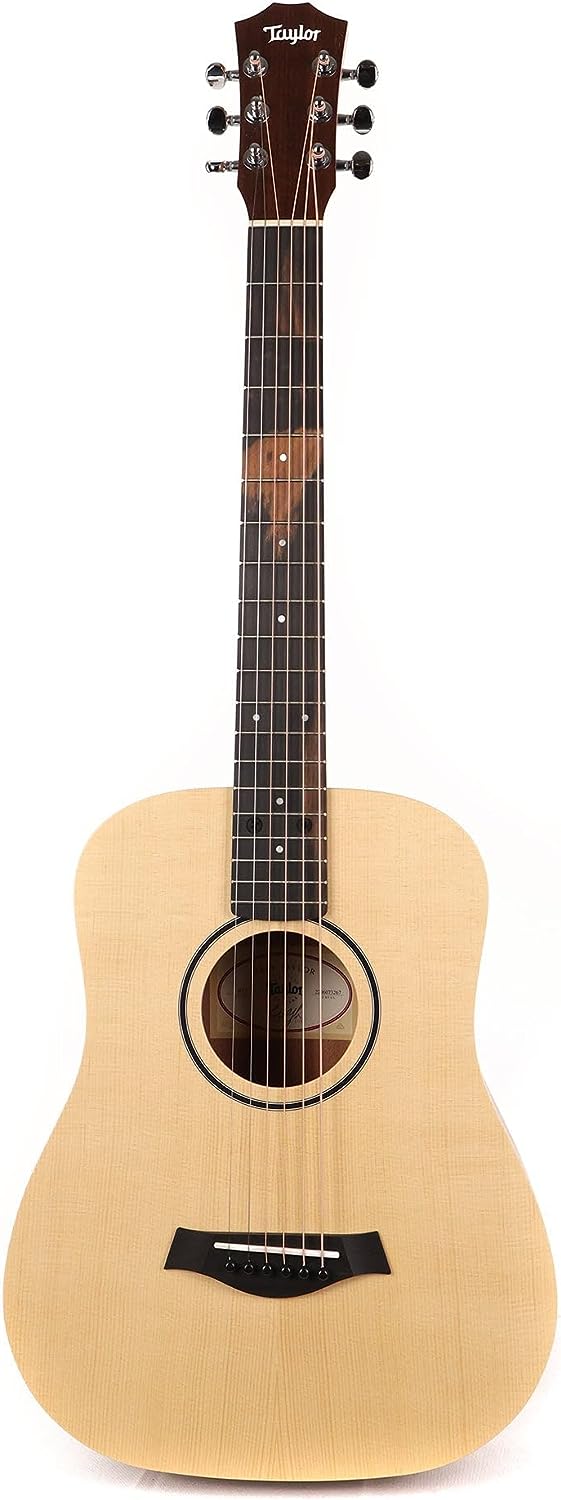
Bearing the distinguished Taylor brand mark, the Taylor Baby Taylor is a left-handed acoustic guitar made with great care and precision.
Its elegant exterior surface is a beautiful natural hue resulting from the Sitka Spruce wood used for the top part of its body.
Delicately chosen Walnut wood from the finest trees is used to craft the rest of the guitar body, including the back and sides.
Adding on to its composition, the neck of this exquisite guitar is made of Maple wood granting it firmness and a classy look.
One can run their fingers over its Ebony fingerboard, which contrasts with its natural colored body.
Additionally, its strings are of Phosphor Bronze material, which enhances the overall look and adds richness to the sound it produces.
This guitar being left-handed, provides a welcome choice for left-hand dominant users.
Further, it comes with a total of six strings, in line with the tradition of acoustic guitars.
The choice of materials used and the expert craftsmanship lends it a very sweet and appealing tone that a music enthusiast would surely appreciate.
- My Review
Upon first glance, I couldn’t help but admire the natural, rustic aesthetic that the Taylor Baby Taylor BT1 Walnut Left-handed Acoustic Guitar provides.
With the walnut used for the body, it lends an earthy dimension to the guitar, which is visually pleasing and unique.
The ebony fingerboard further heightens the overall aesthetic appeal, its stark contrast to the natural finish of the guitar body not only enhances the beauty but also offers a smooth and efficient playability.
The spruce wood top gives it a refreshing touch, perfectly completing the organic vibe.
For left-handed people like me, the left-hand orientation is not just a comfort, rather it feels customized and personal.
Comfort and familiarity immediately rush in when I held it in my arms.
It has six phosphor bronze strings, thoughtfully chosen ensuring a vibrant and richer acoustic sound.
Of note is the maple neck construction, which stands up to the rigors of impassioned playing.
Its robustness is indeed an assurance that it can handle extended usage while maintaining its optimal performance.
Securing a firm grip on it is a breeze due to its design and natural characteristics of maple.
The quality of the workmanship that has been put into producing this instrument is evident at first strum.
Striking the strings releases a tone that is accurate, clear and crisp, staying true to the reputation of Taylor guitars.
There is a considerable difference that the walnut back and sides contribute to the overall sound.
Its impact on the tone tends to make it sweeter and softer, creating a melodic resonance.
One point I would like to mention here is that, even though this guitar sounds remarkably well, those who seek a robust low-end response may not find it here.
Its sound leans more towards the brighter and warmer side, emphasizing on the high-mid range frequency, however, for an intimate, indoor setting this would sound perfect.
Whether you are a beginner or a seasoned guitarist, you would greatly appreciate the quality of this guitar.
It’s not only aesthetically pleasing but also creates a sound that leaves a lasting impression.
Although, there are always ways to improve depending on personal preferences, but for a natural and warm acoustic sound, the Taylor Baby Taylor BT1 is indeed a commendable choice.
- Pros:
- Sitka Spruce wood used for the top.
- Sweet and appealing tone.
- Cons:
- No significant negatives were found.
The clear spruce top and walnut body contribute to a warm, resonant tone that is characteristic of guitars in a much higher price range.
Featuring a maple neck with an ebony fingerboard, this guitar is comfortable for all playing styles and levels of skill.
The phosphor bronze strings and the left-hand orientation add another layer of versatility, making this guitar a great choice for left-handed players looking for an acoustic guitar with a solid performance.
I recommend the Taylor Baby Taylor BT1 Walnut Left-handed Acoustic Guitar – Natural Sitka Spruce for people who value quality, comfort, and a beautiful acoustic sound.
Martin LX1E Little Martin Acoustic Guitar
High-quality, versatile guitar with great playability.
This guitar boasts a professional sound, superior appearance, and enhanced playability, thanks to its Sitka spruce top and high-pressure laminate (HPL) construction. Handmade from sustainable wood, it is designed to be durable for long studio sessions, jam nights, and plenty of strumming or picking. It caters to a variety of music genres and makes a great travel or beginner guitar.
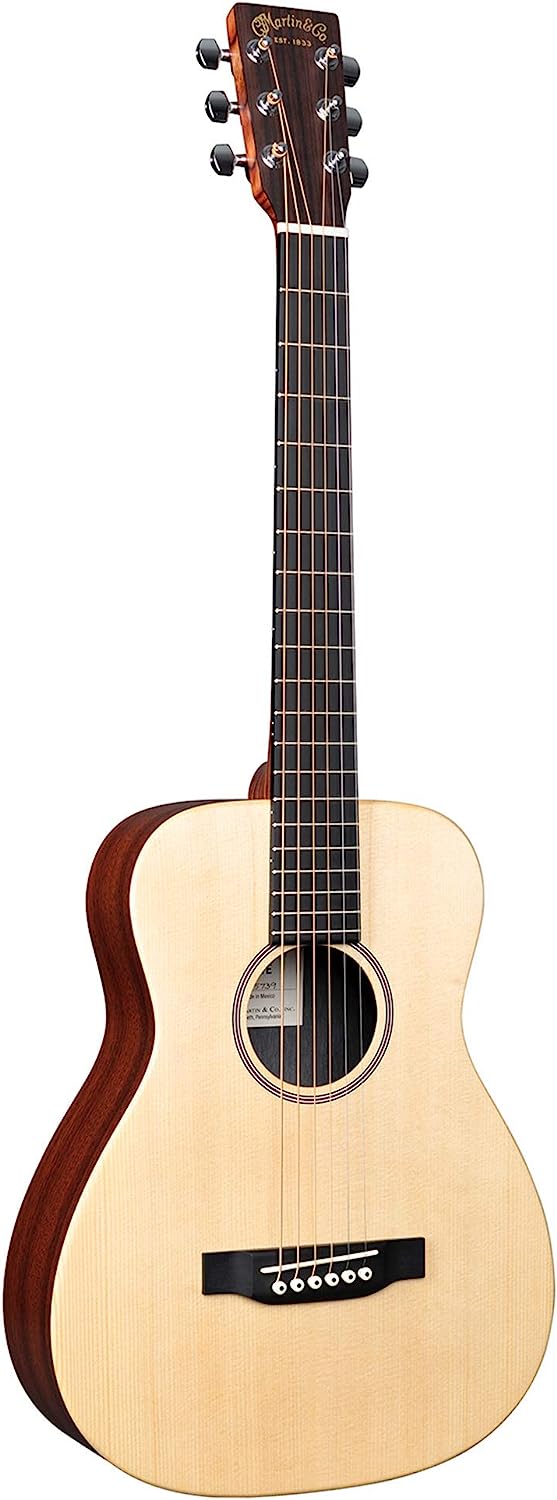
The Martin LX1E Little Martin is an acoustic-electric guitar with a sitka spruce top which is combined with a high-pressure laminate construction, and it is the smallest guitar that Martin produces.
Even though it’s small, it boasts an amazing tone, high quality, and flexibility, making it awesome for playing whether around a campfire or during personal practice sessions.
The Little Martin LX1E comes with a warm satin finish and is made from sitka spruce top and mahogany high-pressure laminate back and sides, which also contributes to its stunning appearance.
Moreover, it has a mortise and tenon neck joint, non-scalloped X-Brace, standard tapered neck, and chrome-enclosed gear tuners.
This solid-wood, acoustic-electric guitar is handmade from the best quality wood, and is designed to endure late-night jamming sessions, long studio sessions, and continuous strumming or picking.
Furthermore, the Little Martin boasts Martin’s globally renowned tone, and not just that, but the guitar enhances playability which makes it a delight to play.
No matter the music genre you’re into – be it rock, country, folk, bluegrass, or jazz – playing these guitars offers an enjoyable and natural experience.
Last but not least, the guitar is primarily composed of mahogany with a fretboard made of morado. It comes in a natural color, and is fitted with a Fishman Isys T electronics configuration, and strung with phosphor bronze strings. It is designed for right-handed players.
- My Review
Upon first glance, your attention is instantly stolen by the satin finish of the Sitka spruce top on this Martin LX1E Little Martin acoustic/electric guitar.
Its small size also effortlessly captures interest, signaling an unexpected ease and portability not usually associated with guitars.
As for the Martin LX1E’s craftsmanship, it is evident that meticulous attention has been given to this instrument, from its mortise and tenon neck joint to the chrome-enclosed gear tuners.
Crucially, while it is small in size, it is undeniably big on resilience, appearing to be well-equipped to win the test of time and use.
I was thoroughly pleased at how comfortably this guitar fitted into my hands, the manageable size enhancing the playability exponentially.
Strangely enough, it did not feel like hugging a packing crate; it offered a cosier, more intimate experience akin to holding a favoured book.
Fantastic to touch, even better to play; strumming or picking on this Little Martin produced an impressive variety of tones that dance gracefully between rock and jazz, country and folk, with subtle hints of bluegrass peppered in between.
And there lies the essence of its professional sound: the easy integration of diverse tones into a harmonious melody.
Although I found that the sound is optimal when amplified, the natural acoustic sound was still pleasurable for a seasoned musician like myself.
The Morado fretboard, coupled with the mahogany neck, provides a luxuriously smooth pathway for one’s fingers to dance upon.
The sound quality dramatically improves with the Fishman Isys T pickup configuration, transforming this little gem into a truly acoustic-electric marvel.
However, I found the guitar tuner slightly disappointing, which seems to be a few cents sharp and lacking a touch of precision.
But this is a small trade-off considering this guitar’s overall excellence and affordability.
Despite being manufactured in Mexico, I assure you that its quality does not deviate from that of an American-made guitar; it is still a Martin.
I believe the Martin LX1E promises not only a fantastic musical experience, but also a ticket to a world of guitar-playing ease, convenience and pure joy.
- Pros:
- High quality build and sound.
- Easy to play for beginners.
- Portable and durable for travel.
- Cons:
- Poor tone noted by some users.
- Some had delivery issues.
- Sound may not satisfy everyone.
My final verdict is that the Martin LX1E Little Martin Solid Sitka Spruce/Mahogany HPL Acoustic/Electric guitar is an exceptional instrument.
Its superior sound, versatile use, and sustainable materials make it a standout choice.
This guitar’s enhanced playability makes it a joy for musicians of all skill levels, and it’s an excellent starter guitar for the young and old alike.
In acoustic-electric guitars, the Martin LX1E is truly a reigning champion.
Yamaha Student Series CGS103AII Acoustic Guitar
Great-sounding, durable Yamaha classical guitar for beginners.
This classical guitar is designed with a spruce top and Meranti back and sides, along with a Nato neck and Rosewood bridge and fingerboard. It is perfect for students learning the ins and outs of classical guitar technique. Proving to be a great-sounding budget guitar, this instrument ensures years of musical pleasure.
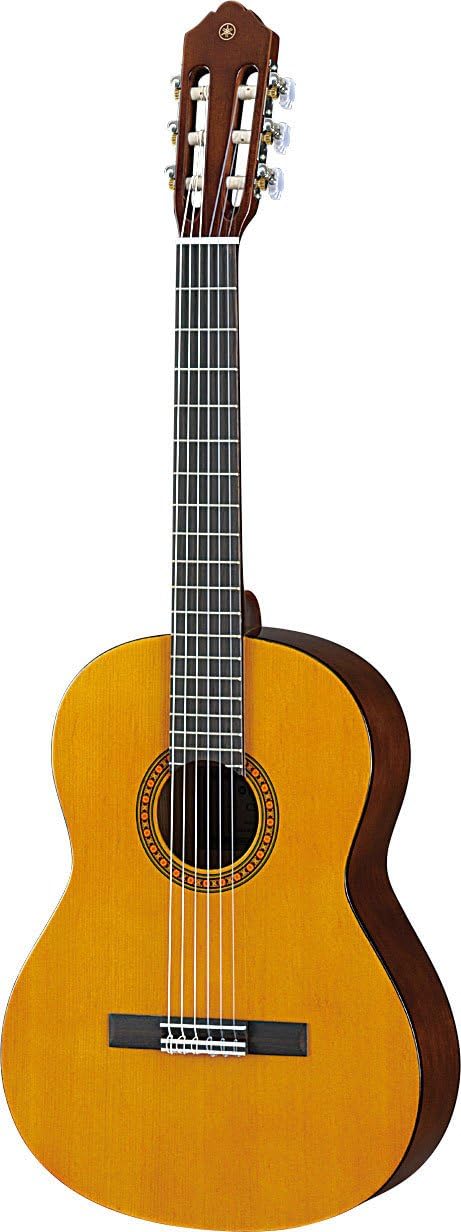
Let’s talk about this classical guitar from Yamaha’s Student series, bearing the model name CGS103AII.
It’s impressive with its natural finish and is crafted from superior materials that are known for their acoustic benefits.
The top plate is made out of Spruce, renowned for enhancing the guitar’s resonance, aiding in producing rich sounds.
Meanwhile, the back and sides of the guitar are composed of Meranti, a choice of wood that is known to balance out the bright tones of the Spruce.
Elements such as the fingerboard and bridge, carry the sophistication of Rosewood.
The natural color of the guitar adds an aesthetic charm to the instrument.
Right-hand oriented, this guitar is strung with Nylon strings and has a standard guitar pickup configuration, labeled as S.
This guitar is the go-to instrument for learners developing their classical guitar techniques, thanks to its unique yet utility-focused features that deliver superior sound quality.
In the hands of a dedicated student, a Yamaha CGS Classical Guitar could turn practice sessions into an absolute joy, promising years of musical satisfaction.
- My Review
Looking at the Yamaha Student Series CGS103AII Classical Guitar, my first impression is that it’s a very pleasing instrument in terms of both appearance and feel.
This guitar is naturally finished, which gives it a lovely aesthetic appeal.
In my hands, it feels incredibly comfortable and inviting, surprisingly so, especially considering its relatively small size.
This guitar is indeed smaller than most, but let me assure you that size is by no means indicative of its quality or playability.
One of the main elements I had to pay attention to was the build quality.
And, with Meranti back and sides, and a spruce top, it’s clear that the CGS103AII has been constructed with care and attention to detail.
Moreover, the rosewood fingerboard and bridge add further to its usability and comfort.
The neck is made of Nato, which is known for its resilience and firmness, assuring you a pleasant playing experience.
What really catches my attention, though, is the guitar’s sound quality.
I found the guitar to produce a delicate yet rich and full tone that’s both warm and balanced.
Upon further investigation, I noticed that the intonation was quite good, staying mostly within the desired range.
However, be aware that the string action is a bit high at the 12th fret, nothing that will ruin your performance, but something worth considering.
In terms of its applicability to both beginners and those with physical limitations, this guitar shines.
Its 3/4 size makes it easier to handle for beginners or those with shoulder and neck issues.
Also, the nylon strings are gentle on the fingertips, allowing for more extended playing sessions without discomfort.
As for cosmetic considerations, the guitar arrived with the strange occurrence of oxidized strings and minor cosmetic body damage.
While it does not affect its functionality, it’s peculiar for a new instrument to ship in this state.
You might want to have a fresh set of strings on hand, just in case.
Bringing the instrument on road trips or camping trips is made effortless due to its compact size.
However, bear in mind it doesn’t sound as impactful as a full-size Yamaha.
Regardless, most find the CGS103AII to be an excellent companion due to its portability and robust build.
While it’s not par on par with a concert-grade instrument, the Yamaha CGS103AII is indeed an excellent choice, especially when considering it for novices or casual play.
- Pros:
- Perfect for beginners and students.
- Comfortable for small hands.
- Good sound for the price.
- Cons:
- Poor packaging during shipment.
- High string action at 12th fret.
- Sound might seem weak to some.
My final verdict is that the Yamaha Student Series CGS103AII Classical Guitar is an exceptional option for those starting on their guitar journey.
Its spruce top and Meranti back and sides create a quality sound that can rival guitars at a higher price point.
The rosewood fingerboard and bridge add a nice touch to the functionality and aesthetics of the instrument.
Moreover, it offers years of musical pleasure at a budget-friendly cost, which is another terrific point in its favor.
I highly recommend this guitar for any beginner looking for a great-sounding, affordable, and long-lasting instrument.
Fender Sonoran Mini Acoustic Guitar
Compact acoustic guitar with full-sized tone.
This compact guitar boasts high-quality construction with a choice of spruce or mahogany top, mahogany back, sides, and neck, along with a walnut fingerboard and bridge. Despite its smaller 23.3” scale length, it mimics the tone of a full-sized instrument and comes with a 6-in-line Strat headstock. Ideal for young or traveling musicians, it offers easy portability without compromising on sound quality.
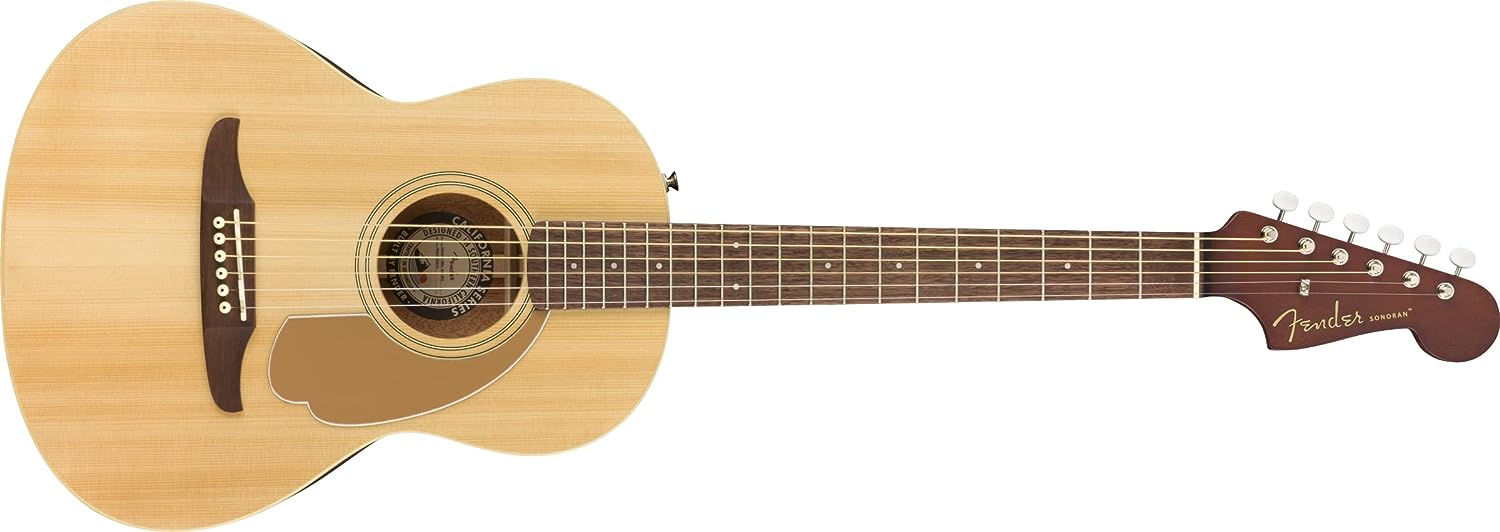
The Fender Sonoran Mini is a unique acoustic guitar that manages to produce the powerful tone of a full-sized instrument while maintaining a smaller size.
Its characteristic look comes from a distinctive Sonoran Mini body shape that is exclusive to the Fender brand.
This guitar’s remarkable tone is its top, which can be either spruce or mahogany, set with a scalloped “X” bracing and paired with mahogany back and sides.
Despite being slightly smaller with a 23.3” scale length, it doesn’t compromise on the quality of the sound.
It also boasts a slim-taper “C”-shaped profile nato neck that combines well with a walnut fingerboard and bridge, and a unique six-in-line Strat headstock, a nod to Fender’s iconic electric guitars.
The instrument is ideal for right-handed players and features a phosphor bronze string material, adding to its robust, resonant sound.
The Sonoran Mini is offered in a soothing natural color and comes with durable mahogany materials for the neck, top, back, and body.
Its design and build make it a perfect choice for both up-and-coming young players and seasoned guitarists looking for a reliable, compact yet high-quality travel guitar.
Lastly, this guitar is sold with a gig bag, adding that extra convenience for musicians on the move.
- My Review
I’ve had the pleasure of playing the Fender Sonoran Mini Acoustic Guitar and I have to say, it’s quite a delightful little instrument.
Upon opening the accompanying gig bag, one is immediately struck by the naturally wonderful aesthetic of the guitar.
The walnut wood of the fingerboard and bridge provides a lovely contrast to the beautiful mahogany body.
I’ve found that the Fender-exclusive Sonoran Mini body shape holds up quite well even in comparison to its full-sized counterparts.
Don’t be fooled by its smaller size, as the quality of the sound is unexpectedly robust for a 3/4 body size.
The mahogany used on the top panel, in concert with the scalloped “X” bracing design, certainly contributes to the rich and warm tones produced by this guitar.
While playing, I’ve noticed a certain ease of travel along the walnut fingerboard which greatly enhances the playing experience.
This, coupled with the slim-taper “C”-shaped profile of the mahogany neck, provides a greater playability than I originally anticipated.
The phosphor bronze strings lend a certain vibrancy to the overall sound, which will leave the player and the listener thoroughly satisfied.
Another standout feature is the 6-in-line headstock, a clear nod to Fender’s iconic electric line, which nicely blends the traditional and the modern.
In terms of volume and sustain, the Fender Sonoran might not be as loud as some would prefer, but its sound still rings clear and sweet.
One thing to note is that the included gig bag, while functional, does lack in padding, perhaps suggesting that this model is intended more for home use and travel, than for professional gigging scenarios.
Nevertheless, I feel that the quality and affordability of the Sonoran Mini, combined with the convenience of its smaller size, more than make up for any minor drawbacks.
Whether you’re a beginner looking to learn on a high-value instrument, or an experienced player in need of a reliable travel guitar, the Fender Sonoran Mini makes an excellent choice.
You can be assured of getting an instrument that’s easy to handle, comfortable to play, and, most importantly, produces a beautiful, resonant sound.
- Pros:
- Great for young and beginner players.
- Produces sound like a full-sized guitar.
- Compact and travel-friendly size.
- Cons:
- Not ideal for playing in front of an audience.
- Comes with a low-quality gig bag.
- Limited volume and sustain.
My final verdict is that the Fender Sonoran Mini Acoustic Guitar is an excellent choice for those seeking a compact and portable instrument with superb sound quality.
This guitar, with its top-notch materials such as mahogany and spruce, delivers a powerful punch in a small package.
The unique 6-in-line Strat headstock, inspired by Fender’s iconic electric legacy, adds a stylistic touch that sets it apart.
So, whether you’re a young aspiring player or simply need an easy-to-travel guitar, the Sonoran Mini should definitely be considered.
Its fit and finish, sound quality, and ease of use make it a standout in its class.
Yamaha APXT2 Acoustic Guitar
Compact, high-quality guitar perfect for travel.
This compact, well-constructed acoustic-electric guitar is great for travel, featuring an ART-based pickup system and Yamaha’s proprietary tuner for quick, accurate tuning. It has a spruce top, rosewood fingerboard and bridge, with a gig bag included for easy transport. Made from quality materials including meranti body and nato/mahogany neck, it’s perfect for right-handed players seeking a reliable companion for their music journeys.
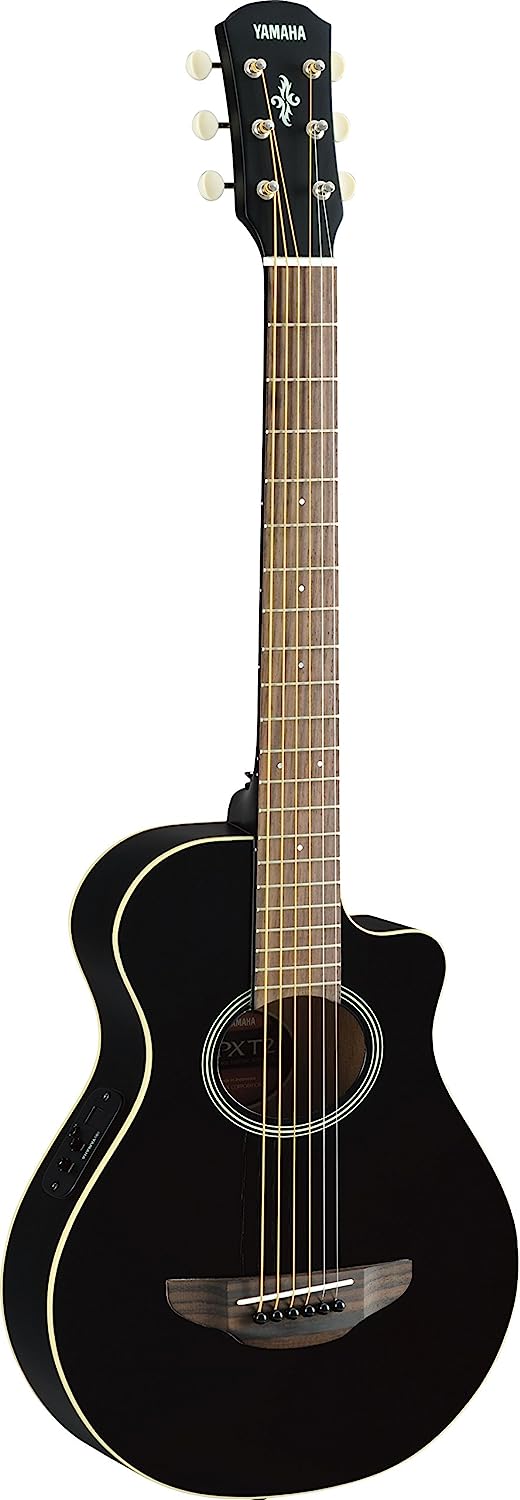
Let’s talk about the Yamaha APXT2, which is a compact version of the globally renowned acoustic-electric guitar, the APX500III.
It’s not only slightly smaller with a 3/4 size ratio, it’s also an excellent choice for travel due to its constructed design just right for the road.
Equipped with an ART-based pickup system and Yamaha’s unique tuner, this guitar guarantees high performance sensitivity and precision, making the tuning process swift and efficient.
In addition, the Yamaha APXT2 comes with a built in gig bag for your convenience.
This guitar also sports a top layer made of spruce wood and a fingerboard and bridge crafted from rosewood.
To strengthen its body, it has the back and neck made from durable materials such as Meranti, Nato and Mahogany, providing balanced sound and great tone.
You’ll find the guitar strings are made of nickel, which provides a bright, lasting tone.
This right-handed guitar also comes with attractive black ABS bridge pins.
There’s no doubt that the Yamaha APXT2, presented in a classy black color, is a quality product from the well-known and reliable brand, Yamaha.
- My Review
Having played the Yamaha APXT2 3/4-Size Acoustic-Electric Guitar, I was immediately struck by the high-quality construction.
As a 3/4 size version of their best-selling model, it’s an incredibly compact and convenient instrument to take on the road.
The spruce wood top’s richness combines with the rosewood fingerboard’s detail and bridge to give off a robust aesthetic.
My fingers danced across this instrument’s fretboard, praising its ease of play due to the short scale.
Strumming it, I was welcomed with an exceptional resonance coming from the meranti body material.
However, despite its beauty and quality construction, a few areas could be improved upon.
Notably, the original set-up required some tweaking to get the action and intonation right.
Once these adjustments were made, the guitar performed spectacularly.
Matching its rich sound, Yamaha has built in an ART-based pickup system and their revered proprietary tuner.
These inclusions make tuning a quick, accurate process and offer a fantastic sensitivity during use.
This guitar is not just an acoustic instrument but also an electric one, thanks to the piezo pickup configuration.
While the guitar may come across as boxy due to its travel-sized design, the sound quality is unquestionably Yamaha.
An added bonus is the gig bag that comes included with your purchase.
From my time playing the Yamaha APXT2, I’ve noticed that it’s a great fit for guitarists with smaller hands or those who prefer a compact instrument with a full-sized sound.
But, even though this guitar performs excellently for its size, be prepared for the fact that it won’t deliver the sound of a full-size dreadnought.
However, with the right expectation, this guitar won’t disappoint.
As for the Meranti body material and Nato/Mahogany neck, they further enhance the guitar’s overall durability, feel, and tone.
Speaking of tone, the System 68 pickup does tend to be sensitive, and some may find the high frequencies overpowering.
Let’s not forget the right-oriented string material, made from nickel, adding another layer of quality to this instrument.
While this guitar would be an excellent choice for both beginners and experienced players, the hand orientation is something to keep in mind if you’re left-handed.
Finally, the Black ABS bridge pins are another thoughtfully added feature that boosts the quality of this instrument.
- Pros:
- Excellent sound for its size.
- Suitable for travel and small hands.
- Includes built-in tuner.
- Cons:
- Fingerboard stains customers’ fingers.
- Could be seen as a “kid’s guitar”.
- Some report as overpriced for the quality.
My final verdict is that the Yamaha APXT2 3/4-Size Acoustic-Electric Guitar – Black is an exceptional instrument.
Its spruce top and rosewood bridge and fingerboard contribute to a remarkable tone quality.
This guitar’s ART-based pickup system and proprietary tuner offer high sensitivity and accuracy, perfect for all musicians.
The inclusion of a gig bag also adds value to the overall package.
I highly recommend it for those seeking a compact, well-constructed travel companion.
Lyons Classroom Acoustic Guitar
Economically priced, durable with beautiful tone quality.
This economical guitar is designed with a spruce wood top and neck for attractive sound and appearance. It’s built to withstand classroom environments and has features such as a 19-fret, slotted headstock and a gloss finish. The durable instrument comes in half or full sizes, caters to right-hand users, and boasts six nylon strings for a delightful musical experience.
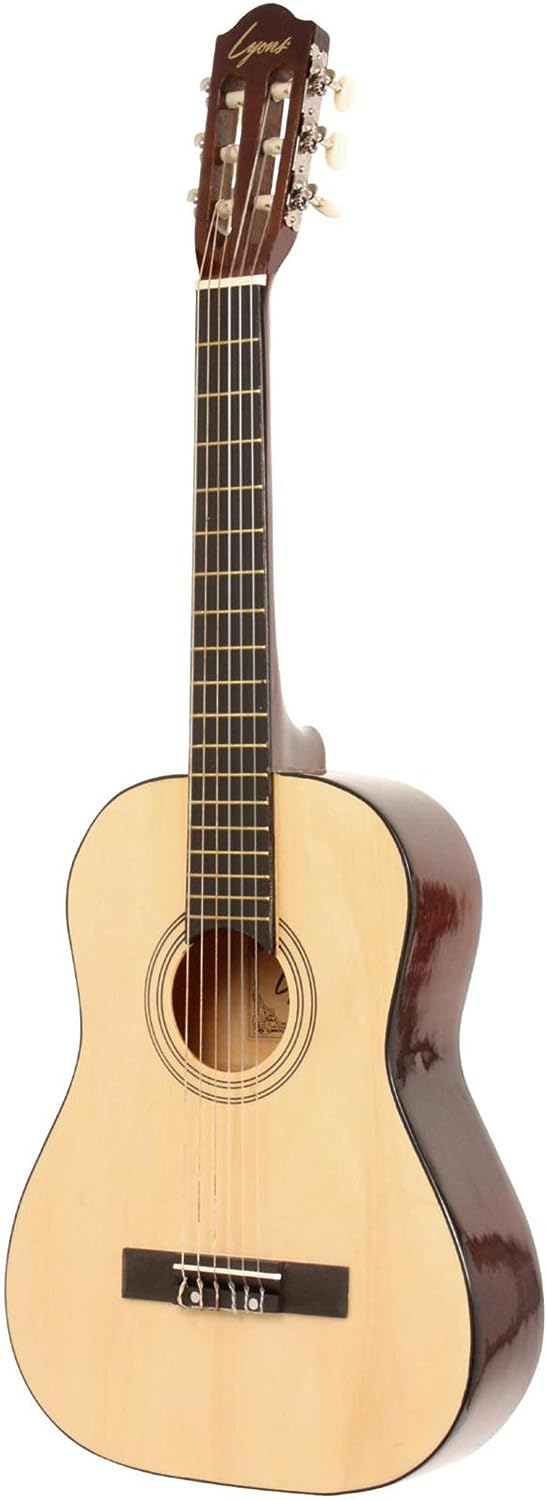
This is a Lyons 1/2 Size Classroom Guitar, specially constructed to cater to a training environment.
It boasts a top layer of laminated spruce, making it durable and resonant.
The guitar headstock is slotted, a feature that adds to its overall aesthetics.
It offers 19 frets, providing a wide range for creating music.
An attractive feature is the vibrant rosette included in the design.
Additionally, it has a gloss finish that enhances its visual appeal.
Produced by renowned manufacturer, Lyons, the guitar offers both quality and reliability.
The top material is made from spruce wood while the body uses a combination of plastic and spruce.
The neck also uses high-quality spruce wood, ensuring a comfortable grip.
The strings are made of nylon, which produces soft yet rich sounds.
This guitar is designed for right-hand orientation and comes with a standard set of six strings.
It’s crafted not only for its tonal quality and look but also for its economical pricing and durability, proving perfect for a classroom setting.
Fittingly, it’s available in both full and fractional sizes, offering options for different learner needs.
- My Review
The Lyons Classroom Guitar 1/2 Size instantly catches the eye with its colorful rosette and gloss finish.
Personally, I found the laminated spruce top to be thoughtfully designed, since it not only brings out a polished look but also contributes to the durability of the instrument.
Made to withstand the ever-busy classroom environment, this guitar is, in my opinion, economically priced.
Upon tuning up, I noticed the strings -made of nylon- produce a sound that’s particularly soft and warm.
As I played, I also discovered that the nineteen-fret setup of the fretboard offers a reasonable range, allowing for varying pitches and chords.
One point to note is that its right-hand orientation might not be suitable for left-handed players.
While the body material is part plastic and part spruce, I must admit that it is a clever design choice considering the classroom setting where the guitar is bound to take a knock or two.
This guitar is not just about durability, also its unique slotted headstock design caught my attention, adding a touch of classic elegance to the overall appearance.
Moreover, the spruce wood neck ensures a comfortable grip and ease of play, even during longer practice sessions.
Despite the good value for money, I should mention that the quality of the spruce wood used in the guitar could be improved to garner better tones and resonance.
Note that the sound won’t be as depth-filled or resonant as some of the higher-end guitars, but one must understand that this is not its intended purpose.
Providing it is meant to be a ‘classroom guitar’, I believe it is perfectly fit to facilitate beginner’s lessons and learning chords in a more forgiving way.
Being available in full and fractional sizes, it caters to different age groups or individuals with smaller hands, making it a versatile choice.
However, those seeking a richer tone or more advanced techniques might find it limiting.
Last but not least, it must be considered that the string material, nylon, while it facilitates comfortable and easy play for learners, might not meet preferences of all, particularly those used to steel strings.
All things considered, the Lyons Classroom Guitar 1/2 Size is a solid entry-level guitar that, in my view, balances function and aesthetic appeal quite well.
As the product reviews provided are blank, I’ll use general pros and cons for a guitar of this description:- Pros:
- Laminated spruce top.
- Economically priced.
- Designed for classroom environment.
- Cons:
- Body made of plastic material.
- Only for right hand orientation.
My final verdict is that the Lyons Classroom Guitar 1/2 Size has earned a place as a sound choice for beginners and classrooms.
With its laminated spruce top and nylon strings, it manages to combine quality and economy in a manner that is truly noteworthy.
The gloss finish and colorful rosette add an aesthetic appeal that is sure to make the player stand out in a crowd.
It should, however, be noted that the use of plastic in the body may not satisfy those in search of a more authentic guitar experience.
Still, for its price point and target audience, this instrument is a value-for-money proposition that should not be ignored.
Fender CP-60S Parlor Acoustic Guitar
Comfortable, warm voice with easy-to-play neck.
This acoustic guitar offers a warm, intimate voice perfect for folk and blues thanks to its parlor body style. The guitar is built with a solid spruce top, mahogany back and sides, and a 20-fret walnut fingerboard, ensuring durability and quality sound. Other notable features include chrome die-cast tuners and a rosewood bridge, although a case is not included.
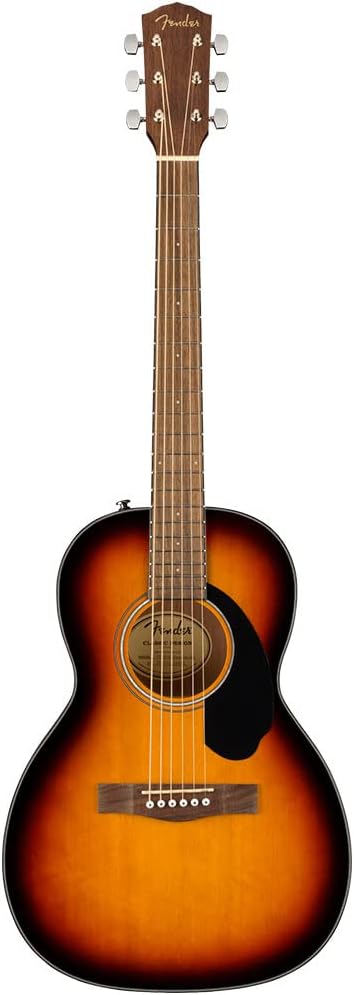
This Fender CP-60S Parlor Acicoustic Guitar comes in a 3-color sunburst tone, a brand renowned for superior quality musical instruments.
Constructed with a solid spruce top and a back plus sides comprised of laminated mahogany wood, this guitar promises durability.
The 24.75″ scale mahogany neck features a 20 fret walnut fingerboard adding to its user-friendly features, especially for guitarist in their learning stages.
This guitar model is supported with chrome die-cast tuners, providing seamless and accurate tuning.
It also boasts of a rosewood bridge, however, note that the purchase does not include a case.
The build and materials used comprise of mahogany, spruce and rosewood, providing this Fender guitar not only durability but also acombination sound pickup.
It uses a string made of phosphor bronze, specially designed for the right-hand oriented guitarist.
Perfect for a folk and blues player, this CP-60S model’s parlor body style offers a comfortable handling due to its compact size.
With a rolled fingerboard edges and a new shape making it easy to play, the guitar produces a distinctly warm and intimate voice that is characteristic of Fender.
- My Review
Upon unwrapping the Fender CP-60S Parlor Acoustic Guitar, I was immediately struck by the captivating detail of the 3-Color Sunburst design.
The guitar’s solid spruce top so beautifully contrasts with its laminated mahogany back and sides, which not only adds to its aesthetic appeal but it also contributes significantly to the guitar’s impeccable sound quality.
The guitar’s neck is a comfortable 24.75″ scale mahogany, featuring a 20 fret walnut fingerboard and I found its easy-to-play neck shape extremely comfortable, enhancing my playing experience substantially.
Besides the perfect fretboard, the chrome die-cast tuners and rosewood bridge attest to the craftsmanship that has gone into producing this instrument.
In terms of sound, this Fender is equipped with a combination style guitar pickup, and strung with phosphor bronze material, producing a warm and intimate voice that I personally appreciated.
However, the tuners left much to be desired in terms of their functionality, they needed slight adjustment over time to maintain the guitar’s tone.
The Parlor body style was comfortable and gave the instrument that distinct sound traditionally embraced by Folk and Blues players, making it an excellent choice for someone like me who appreciates the nuances of both genres.
Notably though, the guitar could also cater wonderfully for the beginners or those suffering from arthritis due to its small size which makes it easier to hold and play.
This is certainly a huge plus, as usability often becomes a barrier for the senior players or those with similar physical restrictions.
Aesthetically speaking, the 3-color sunburst lends a timeless, classic appeal to the instrument that I quickly became fond of.
Unfortunately, the item does not include a case, so additional purchase is required if you’re looking to protect your investment.
Despite this, I found the Fender CP-60S overall excellent in terms of value for money, and would recommend it to players across all levels.
And, let’s not forget, the brand Fender in itself already suggests-sturdy build, great sound and years of musical companionship!
So, whether you’re a novice on a tight budget, or a seasoned player seeking a comfortable, home-size guitar, the Fender CP-60S Acoustic Guitar definitely proves itself to be a sweet deal!
- Pros:
- Comfortable for smaller players.
- Warm, intimate sound.
- Good for beginners.
- Cons:
- Machine heads need replacing.
- Case not included.
- Slightly more expensive.
My final verdict is that the Fender CP-60S Parlor Acoustic Guitar is a remarkable instrument for its price point.
With its solid spruce top and mahogany back and sides, this guitar produces a warm and intimate voice suitable for folk and blues music.
The smaller parlor body style and new easy-to-play neck shape make it a joy to play, particularly for fingerstyle players.
Despite the lack of a case, the chrome die-cast tuners and beautiful 3-Color Sunburst finish add significant value.
This model is an excellent choice for beginner and intermediate players who need a dependable, yet affordable acoustic guitar.
Gretsch G9500 Jim Dandy 24″ Flat Top Acoustic Guitar
Vintage-style guitar with warm, resonant tone.
This acoustic guitar features a basswood body with X-bracing and a nato set neck for a powerful, resonant voice. The walnut fingerboard comes with vintage-style frets and pearloid dot inlays for pleasing aesthetics. Its compact size, along with its high quality sound, makes it perfect for beginners, professionals, songwriting, and travel.
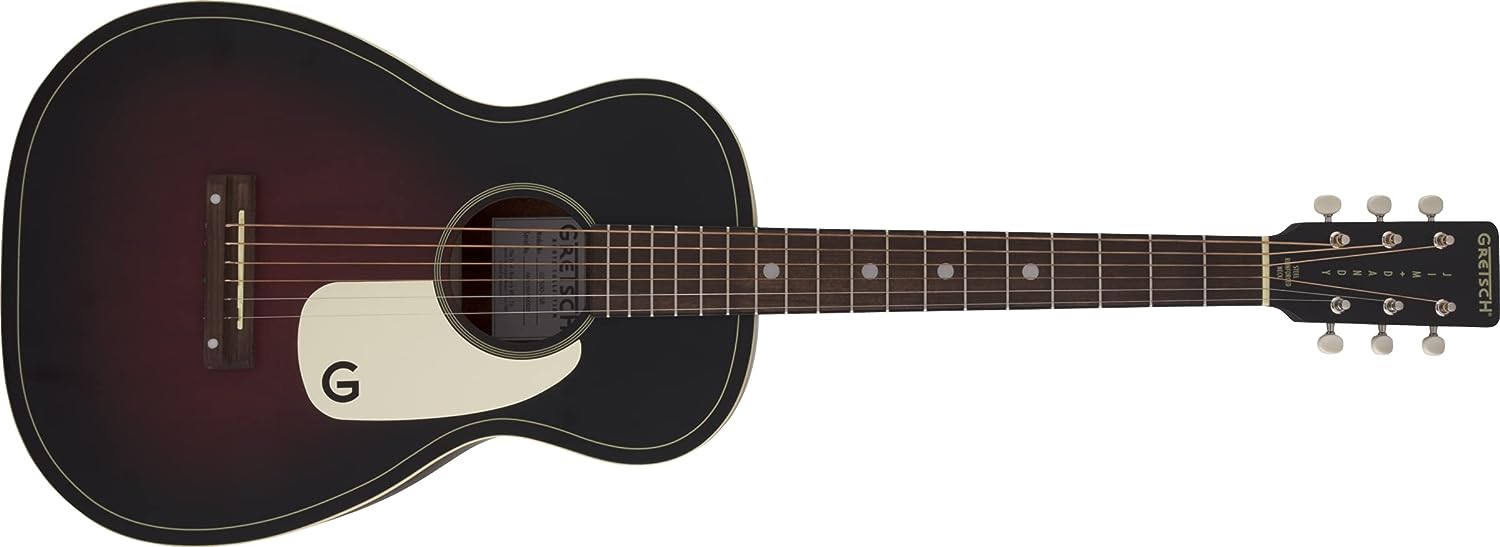
The Gretsch G9500 Jim Dandy is a 24″ flat top acoustic guitar, which sports a striking 2-Color Sunburst color.
True to Gretsch’s legacy, the design mirrors the traditional Rex parlor guitars from the earlier decades.
Remarkably, the body of the guitar is made from robust Basswood and is structured with an X-bracing for enhanced sound projection.
Notably, this guitar features a 24”-scale nato set neck with a synthetic bone nut, providing endless comfort for extended playing sessions.
Additionally, it boasts 18 vintage-style frets embedded in a walnut fingerboard with pearloid dot inlays, enhancing its traditional aesthetics.
The guitar has a walnut bridge and a compensated saddle, promising consistent intonation across the neck.
Furthermore, the guitar showcases a classic Frontier Stain finish with 1950s-style vintage open-gear die-cast tuning machines, maintaining a consistent vintage theme.
It’s perfect for different playing styles like picking and fingerstyle, and is apt for various use-cases – from songwriting to practice sessions, or even as a travel guitar.
Whether you’re a beginner just starting out, or a professional looking for a compact solution, the Gretsch G9500 Jim Dandy promises a resonant and full-bodied tonal output, inspiring you to explore more of your musical journey.
- My Review
First things first, I was quite impressed by the Gretsch G9500 Jim Dandy 24″ Flat Top Acoustic Guitar’s sturdy construction and resonant tones.
The guitar’s basswood body contributes significantly to its pleasing, warm tones and the midrange heaviness is particularly noteworthy, especially on the higher positions on the fretboard.
Aside from the pleasant tone, the convenience offered by the 24″ scale of this model has not gone unnoticed. It provides an endless reach for comfort during extended playing sessions.
Good fingerstyle playability is one advantage of this instrument, thanks to its X-braced body and top-load walnut bridge with a compensated saddle.
When it comes to aesthetics, this guitar has a vintage quality, reminiscent of iconic parlor guitars from the ‘30s, ‘40s and ‘50s.
Even the Frontier Stain finish gives the guitar a look and feel that would appeal to any lover of vintage acoustics.
Adjusting to the guitar’s rectangular, chunky neck may be necessary for some players, especially if they’re accustomed to a different style.
The guitar comes with open gear tuners, which, while functional, may not be preferred by all players.
An interesting feature is the guitar’s single-ply white pickguard, bearing a graphic “G,” adding a retro charm to the instrument.
Being someone who values easy playability in my guitars, I found the Gretsch G9500 Jim Dandy 24″ quite enjoyable.
However, the fretboard can feel a bit dry, and might require some conditioning to enhance its feel.
Despite the need for some minor adjustments, this Gretsch model remains a compelling option, especially for beginners or travelling musicians looking for a compact, easy-to-handle instrument.
Its timbre is charming for such a small-sized guitar, making finger picking effortless and producing a full-sounding bass, despite its compact stature.
The 12th fret joining the body may pose a challenge to those used to a guitar with a larger scale, but this should not be a deal breaker as the overall playability remains pleasant and easy.
The Gretsch G9500 Jim Dandy 24″ Flat Top Acoustic Guitar is a fitting companion for intimate acoustic jamming or a low-key gig, offering a balanced mix of class, convenience, and commendable sound output.
- Pros:
- Produces unique blues tones.
- Portable and easy to play.
- Good for both beginners and pros.
- Cons:
- Action might be high for some.
- Fretboard can feel rough.
- Not ideal for strumming.
The guitar’s Basswood body and X-bracing provide a warm and resonant tone, making it an excellent choice for both picked and fingerstyle playing.
The 24” scale and Smooth-playing walnut fingerboard add to user comfort, ideal for long practice sessions or performances.
Its vintage-inspired aesthetics, inclusive of 2-Color Sunburst finish and pearloid dot inlays, add a nostalgic charm that is often missing in modern guitars.
Whether you’re a beginner needing a reliable first guitar, or a seasoned pro looking for a quality instrument, the Gretsch G9500 Jim Dandy satisfies on all fronts.
Taylor GS Mini Acoustic Guitar
Compact Taylor guitar with exceptional sound quality.
This compact acoustic guitar from Taylor offers rich, full sound thanks to its design mimicking the popular Grand Symphony style. It comes with a Sitka spruce top, laminated Indian rosewood back and sides, and an ebony fretboard. Despite its small size, the guitar delivers big sound making it a perfect choice for those seeking quality in a portable package.
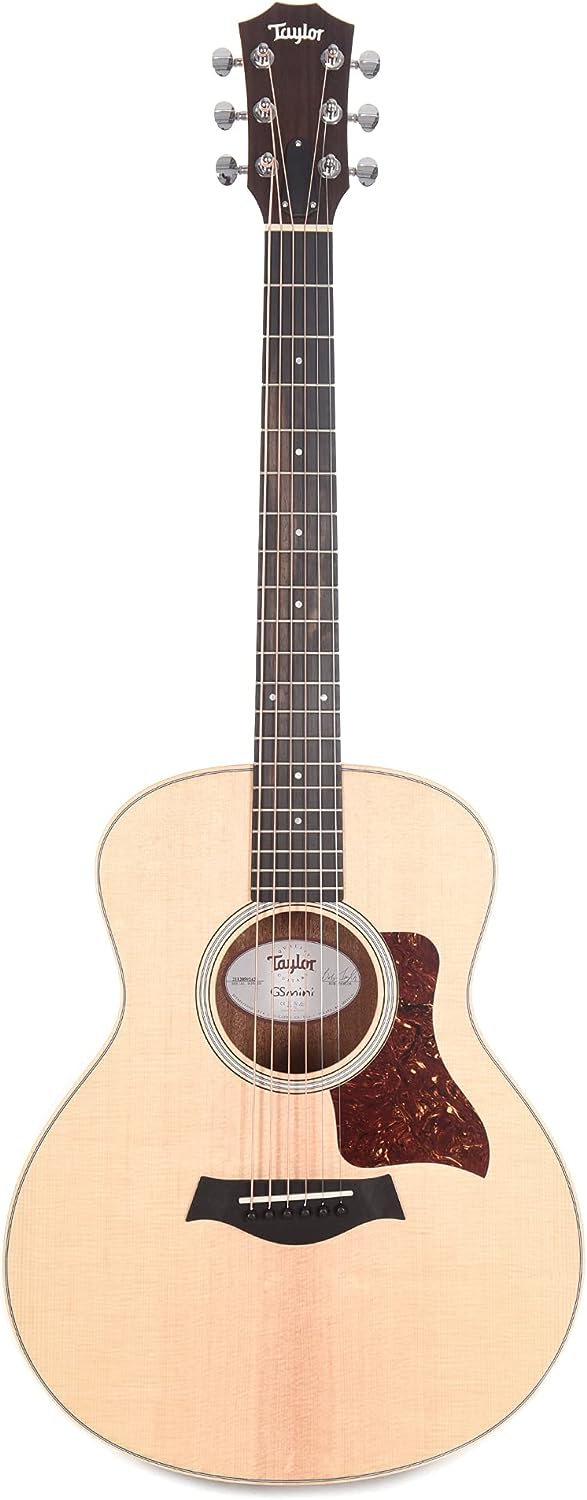
The Taylor GS Mini Rosewood Acoustic Guitar – Natural is a compact yet powerful musical instrument.
Designed for portability, this guitar belies expectations with its robust sound, crafted from the Grand Symphony style.
It’s not just a mini version of a full sized guitar, but a musically superior instrument in its own right.
The richness of sound is brought about by its Sitka Spruce top, laminated Indian Rosewood back and side and an ebony fretboard.
Despite its small size, it produces a full-bodied sound that typically comes from larger guitars.
Constructed with a 23.5″ scale length, it features a right-handed orientation and uses Phosphor Bronze for its strings..
The body, back and neck of this guitar are all crafted out of Rosewood, with a special use of Rosewood Laminate for the back.
Natural-colored, this guitar comes inclusive of a gig bag, that adds to its travel-friendly credentials.
The Indian Rosewood back, laminated for durability, complements the ebony wood fretboard impeccably.
This guitar unmistakably showcases the exemplary craftsmanship Taylor is renowned for.
Whether you’re a seasoned player or a beginner, the Taylor GS Mini Rosewood Acoustic Guitar – Natural is quite the musical companion to have.
- My Review
Upon first glance, it’s easy to appreciate the magnificent craftmanship that the Taylor GS Mini Rosewood Acoustic Guitar boasts.
The striking natural finish, combined with the superior Indian Rosewood laminate back and sides, instill this instrument with an undeniable elegance.
Importantly, this guitar is not only about looks, as the Sitka spruce top and the ebony fingerboard contribute to a rich and full sound that is simply delightful to the ears.
Of particular interest is the back of the body, which sports a slight belly arch – a subtle feature that greatly enhances the instrument’s sound quality.
Moreover, the provided gig bag serves as a thoughtful addition, promising to keep your instrument safe during travels.
Transitioning to the handling and playability of the GS Mini Rosewood, I was particularly impressed by its compact size which didn’t compromise on the sound quality – this makes it a great choice for musicians on the go.
Straight out of the box, the guitar plays exquisitely well, something not always seen with other models in the market.
Furthermore, I must commend the great quality phosphor bronze strings that feel nice under the fingers, and contribute to the overall playing experience.
Also, I have to mention the outstanding build quality of this guitar – despite it being one of the more affordable models, it can certainly stand its ground when compared to its pricier counterparts.
One point of concern though could be the somewhat unconventional design of the guitar’s back which, while enhancing the sound, might take some time getting used to for some players.
However, this minor setback is easily eclipsed by the instrument’s overall sound performance and aesthetic appeal.
For anyone considering a 3/4 size model, I strongly endorse the GS Mini Rosewood as the way to go – this acoustic guitar truly delivers on its promise of big sound in a small package.
- Pros:
- Great sound and build quality.
- Included gig bag is high quality.
- Excellent packing and shipping speed.
- Cons:
- Back belly/arc design isn’t mentioned.
My final verdict is that the Taylor GS Mini Rosewood Acoustic Guitar is a truly impressive instrument.
Its compact size does not compromise the big, rich sound, which sets it apart from many other small guitars.
The quality of construction and materials used, including the Sitka spruce top, Indian rosewood back, and ebony fingerboard are all top-notch.
Regardless of your level of guitar playing, this instrument would make an excellent choice for both its sound quality and portability.
This guitar is worth the investment and highly recommended.
Rogue Starter Acoustic Guitar Acoustic Guitar
Ideal, affordable starter guitar for kids.
The guitar features a small body style, making it ideal for kids or aspiring musicians with smaller frames. It comes equipped with a maple neck, rosewood fretboard, and Martin strings that contribute to its sweet tone. Its components include Agathis body material, 6 strings, and it is designed for right-hand orientation.
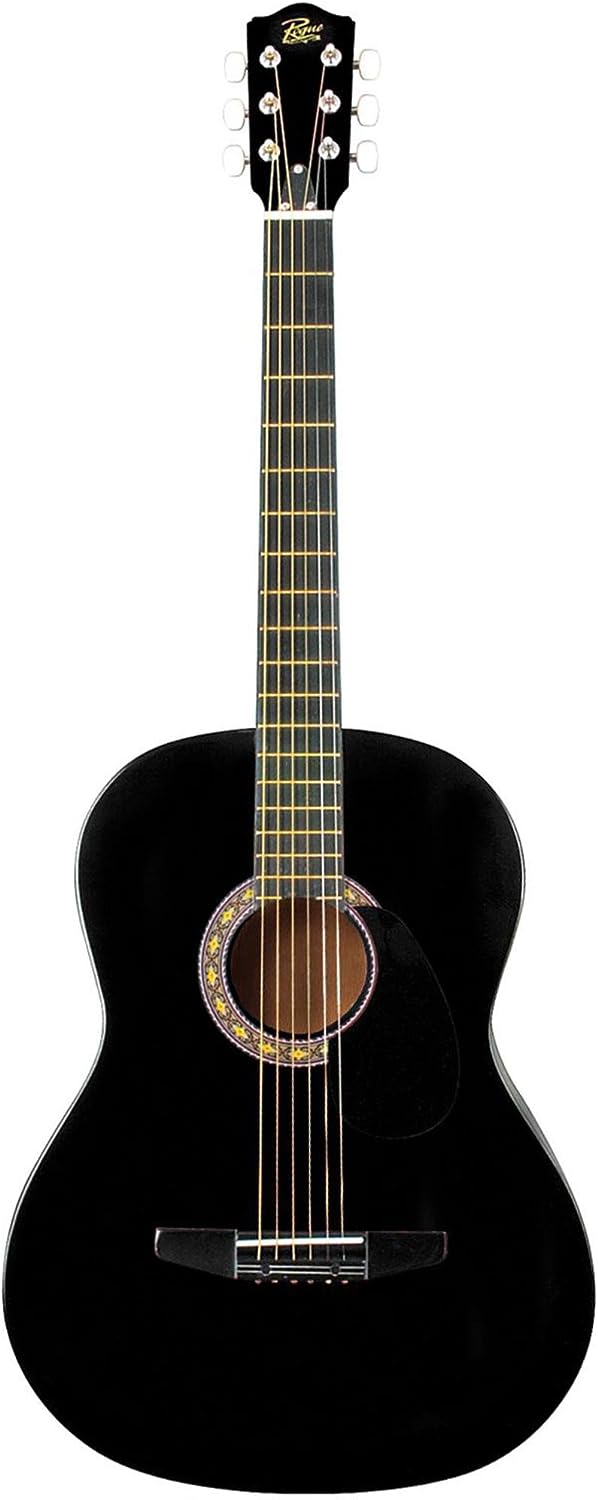
The Rogue Starter Acoustic Guitar is an excellent choice for beginners, with its unique small-bodied design, especially suitable for children or those with a smaller stature.
Constructed with an 7/8 scale, it features a body composition of Agathis, a resilient and lightweight material, adding to the overall simplicity of handling this instrument.
Noteworthy, this guitar sports a maple neck, being accentuated by a stylish and smoothly finished rosewood fretboard, elevating its overall aesthetic appeal while ensuring comfortable playing.
This guitar boasts of specialty Martin strings, renowned for their ability to produce a sweet, rich tone that enhances the overall musical experience.
Moreover, it comes in an alluring black color, making it an attractive piece to add to any music enthusiasts collection.
Additional features include a distinct right-hand orientation, complimented by a reasonable count of six strings, projecting a well-balanced acoustic sound.
Interestingly, this guitar offers a variety of color options to choose from, allowing the owner to express their personal style. However, it’s worth noting that the case for the guitar needs to be bought separately.
To sum it up, the Rogue Starter Acoustic Guitar exudes a blend of functionality, style, and comfort, perfect for beginner-level guitar enthusiasts.
- My Review
Upon examining the Rogue Starter Acoustic Guitar, it’s evident that it sports a smaller body design, making it a fantastic choice for children or budding guitarists with smaller hands or frames.
This guitar comes in a striking black color and is constructed with a maple neck and rosewood fretboard, providing good durability and longevity.
The inclusion of Martin strings is a pleasant surprise, which certainly contributes to its likable tone.
Delving into the instrument’s features, the use of Agathis as the body material and rosewood for the back is fitting for its overall size and price point.
However, even though it boasts of a right-hand orientation and a total of six strings, minor flaws start to surface upon closer investigation.
I discovered that the action of strings was rather high, making it challenging to play for beginners.
Yet, with some effort and patience, it can be tweaked to a competent playability.
Previously, I’ve noted that the overall quality of the sound can be considered versatile and resonant.
Nevertheless, when compared to higher-end models, it’s undeniable that the sound tends to lean towards being a tad too dull and flat.
On a brighter note, its durability and longevity are quite commendable.
Despite the sound quality wavering at times, the guitar maintains its tuning for extended periods.
In correlation with my previous experience of guitars, I found the extraneous details on this guitar rather concerning.
There seems to be a lack of finesse in certain areas such as the overspray of paint into the guitar’s core and the apparent rough edges.
Owing to its low price, such flaws can be overlooked, but it could be a deal-breaker for some.
Yet, its compact size, affordable price, and decent construction make it a commendable choice among starter guitars.
Regardless of some minor flaws, for a novice or a young learner, the Rogue Starter Acoustic Guitar is a cost-effective and worthy consideration.
- Pros:
- Ideal for kids and beginners.
- Good quality at affordable price.
- Smaller size for comfortable play.
- Cons:
- Unfinished frets can cause cuts.
- Sound quality could be better.
- High string action.
My final verdict is that the Rogue Starter Acoustic Guitar is an excellent choice for beginners, particularly children.
The small-bodied design and 7/8 scale make it easy for young learners to handle.
Constructed with a maple neck and rosewood fretboard, it provides high-quality features at an affordable price.
With Martin strings, it delivers a good tone, making practice sessions enjoyable.
Ideally, the case, which is sold separately, should be included to complete the package.
Yamaha JR1 FG Junior Acoustic Guitar
Compact Yamaha guitar perfect for young players.
This guitar, modeled after Yamaha’s acclaimed FG Series, is crafted with a spruce top, a nato neck, and laminated-wood body to produce an authentic acoustic tone. It’s designed with a smaller body and shorter neck, making it an excellent choice for younger players or those with petite hands. Also perfect as a travel guitar, it comes with a gig bag for secure storage and easy transportation.
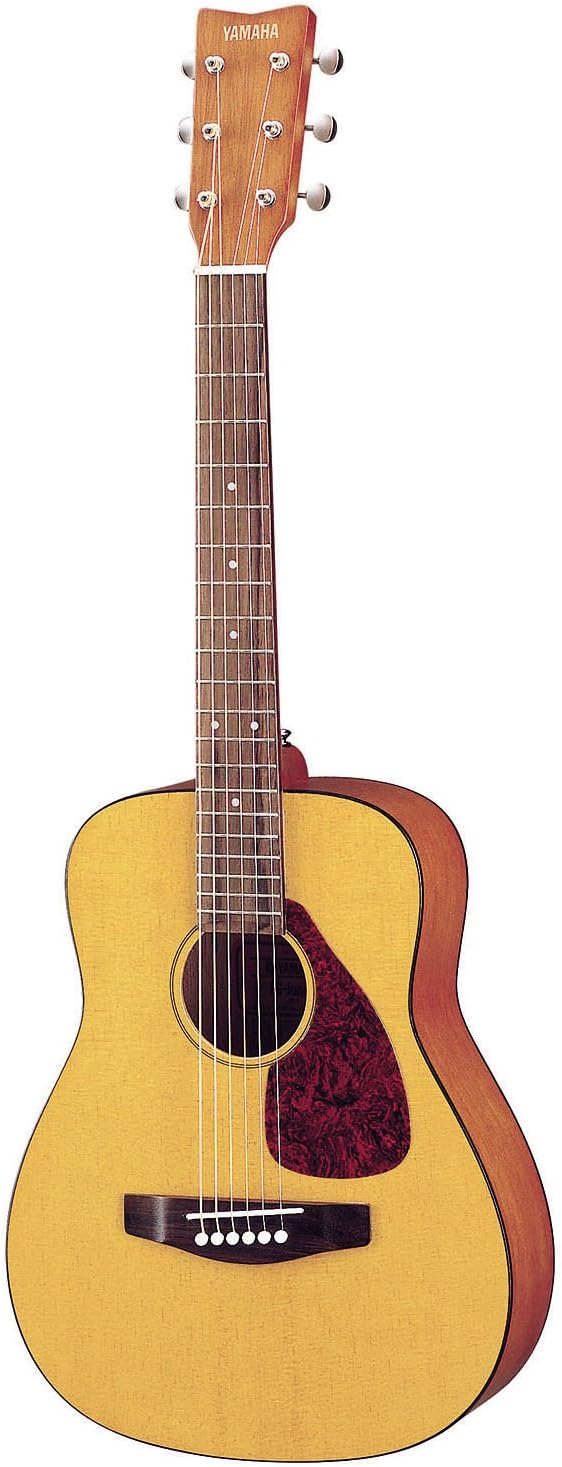
The Yamaha JR1 FG Junior is an acoustic guitar that is shrunk down to 3/4 size, imitating the famous FG Series by Yamaha.
Its compact size, consisting of a smaller body and shorter neck, accommodate those with smaller hands, especially the younger demographic, effortlessly.
The guitar boasts of the exceptional craftsmanship of Yamaha and is furnished with a top made of spruce, which projects an unparalleled acoustic tone.
This guitar also offers its versatility as a travel guitar when conserving space is a priority in your travels.
To ensure safekeeping and uncomplicated transportation, a gig bag comes with the guitar. The saddle is made of Urea.
Delving into the finer details, the body of the guitar is made of laminated-wood, and it sports a natural color.
The back of the guitar is composed of Mahogany, while the neck is made of Nato.
The fretboard is made of Rosewood and the string is composed of Bronze.
The guitar comes with an ambidextrous hand orientation, catering to both right and left-hand players.
The JR1 is a testament to Yamaha’s dedication to quality, featuring a solid, bright tonality, stunning looks, and chrome hardware.
This child-friendly guitar is also equipped with a guitar pickup configuration nicknamed ‘S’. With the convenient and fun playability, this guitar is really the perfect first instrument for a child.
- My Review
Upon laying my eyes on the Yamaha JR1 FG Junior 3/4 Size Acoustic Guitar for the first time, I was immediately drawn to its natural aesthetic.
Its laminate wood body, spruce top, and mahogany back all contribute to a sturdy build that speaks volumes about Yamaha’s craftsmanship.
The fretboard crafted from rosewood accompanied by a nato neck offers a smooth playing experience, which I found to be quite impressive.
Having tried my hand at this versatile instrument, I came to appreciate its ambidextrous orientation, proving its design caters to the needs of all types of guitarists.
My admiration for the compact design grew when I realized this guitar still packs a punch in terms of authentic acoustic tone, despite its 3/4 scale.
Not only is it an excellent fitting for those with smaller hands or children who are learning, but also, it’s a reliable choice for a travel guitar when you’re on the move.
It does, however, come with a gig bag that ensures safe storage and ease in transport.
Nevertheless, no product is without fault, and it’s key to note that the guitar’s smaller body can potentially pose issues for those with larger hands or taller stature.
Despite the guitar’s size, the string-to-string distance can appear to be a bit of a squeeze especially if your fingers are on the larger side.
On a similar note, I had issues with the guitar going out of tune a little too quickly.
Despite multiple attempts at tweaking, the guitar insisted on wandering away from the perfect tune which might pose a challenge for those particular about their sound quality.
The saddle, which is made of urea, is not compensated and could affect the intonation for guitarists who have a sharp ear.
Also, I spotted some rough areas and tiny debris beneath the guitar’s binding, which points towards possibly rushed or unrefined craftsmanship.
Some might find this does not align with Yamaha’s acclaimed standards of production quality.
However, I would argue that at its price point, the Yamaha JR1 FG Junior 3/4 Size Acoustic Guitar delivers an impressive package that could be just the thing a beginner or a traveling musician needs.
- Pros:
- Excellent starter guitar for kids.
- Good playability and finish.
- Compact and travel-friendly.
- Cons:
- Issues with maintaining tune.
- Possible quality control problems.
- Poor intonation out of the box.
My final verdict is that the Yamaha JR1 FG Junior 3/4 Size Acoustic Guitar is an excellent choice for young or inexperienced players.
This guitar’s smaller body and shorter neck make it incredibly accessible to individuals with smaller hands or those just starting to learn.
The quality craftsmanship that Yamaha is known for shines through in this product, providing it with a beautiful tone despite its compact size.
In addition, the inclusion of a gig bag for safe storage and easy transport is a much-appreciated feature.
The Yamaha JR1 FG Junior is a solid, affordable option for those looking to break into the world of acoustic guitar playing.
What to Look for When Buying Acoustic Guitars for Kids?
When selecting an acoustic guitar for a child, several crucial elements must be taken into account.
The first consideration should be the size of the guitar.
Young children with smaller hands and shorter arms will require a smaller sized instrument.

Guitars vary in size from 1/4 size to full-size, with 1/2 and 3/4 sizes in between, so pay careful attention to the guitar’s proportions.
A guitar that is too big can be uncomfortable to play and may even lead to strain injuries.
Another major factor is the guitar’s material and construction.
Even for children, a guitar should be sturdy and made of quality materials that can withstand general wear and tear.
Keep an eye out for guitars constructed from solid wood, as opposed to plywood or laminate, as they generally have a better sound.
Additionally, how a guitar is strung is an important aspect.
For beginners, particularly younger children, choosing a guitar strung with nylon strings may be more beneficial.
These strings are gentler on the fingertips compared to steel strings, making it easier for beginners to get used to the feel of playing the guitar.
The playability of the guitar should also be evaluated.
Examine the action of the guitar, which is the distance between the strings and the fret board.
If this distance is too high it can make the guitar much more difficult to play, possibly discouraging children prematurely.
Ultimately, the sound produced by the guitar will also play a part in the child’s enjoyment and willingness to continue playing.
Therefore, even though this is a children’s guitar, it should still produce a satisfactory and pleasant sound.
Lastly, remember that the guitar will require regular maintenance.
Ensure your child knows the basics of guitar care, such as how to replace the strings, keep the guitar clean, and store it properly when not in use.
Understand that choosing a guitar for your child is not just about buying a smaller version of an adult guitar.
There are differences in size, materials, strings, and sound that have to be considered.
Make it a goal to choose a guitar that is comfortable for your child to play, encourages their learning, and sparks their passion for music.
With the right guitar, your child may develop a lifelong love for playing and making music.
How to Determine the Right Size of Guitar for Your Child?
When looking at acoustic guitars for a child, one of the most important factors to consider is the size of the instrument.
This is because the size can significantly influence the child’s ability to play and enjoy the guitar.
Typically, guitars are not one-size-fits-all instruments, and particularly so for children in different age groups.
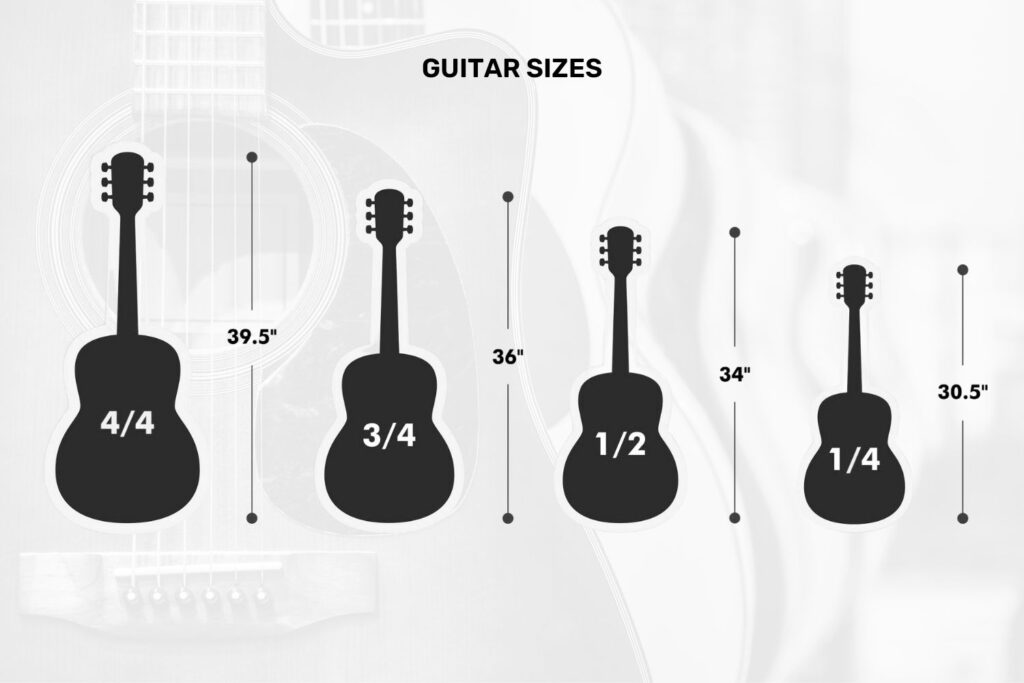
To ascertain the suitable size, you would have to understand the general guidelines on how guitars are sized for various age groups.
Quarter-sized guitars are generally perfect for kids between four to six years old.
If your child is between the ages of six to nine years, then a half-sized guitar would be a suitable fit.
For kids ranging from ages nine to twelve, you would typically get a three-quarter-sized guitar.
For kids aged twelve and above, you might want to consider a full-sized guitar, depending on their physique and comfort.
However, age is just a baseline, and it is crucial to understand that kids grow at different rates.
The height of the child and the length of their arm are also important determining factors to ensure they are comfortable holding and playing the guitar.
The guitar should rest comfortably against the child’s body, and they should be able to strum it comfortably without having to stretch their arm too much.
If a guitar is too big, it may cause discomfort or even muscle strain, discouraging the child from playing.
Conversely, a guitar that is too small may also limit the child’s ability to learn effectively and make playing the guitar challenging.
Along with size, the weight of the guitar is similarly essential for a child.
A lighter weight guitar is easier for kids to handle, reducing the risk of them dropping the guitar or getting tired from holding it.
Do encourage your child to hold and try out the guitar before purchasing as this is the best way to determine if the size and weight are right for them.
Remember, the goal is to find a guitar that your child can comfortably play and have fun with.
A guitar suitable for your child’s size can significantly enhance their learning experience while reducing any discomfort or strain caused by an ill-fitted guitar.
Though it may take some time and trial and error to find the perfect fit, providing your child with a guitar that suits them will pave the way for a smooth and enjoyable musical journey.
Should You Start with a Nylon or Steel-String Guitar for Your Child?
When starting to learn guitar, one of the key decisions parents often face is whether they should invest in a nylon or a steel-string guitar for their child.
Both types of guitars come with their unique set of features and challenges, but understanding these nuances can be instrumental in determining which type would be more suitable for your child.
Traditionally, nylon string guitars, often referred to as classical guitars, have been recommended for beginners, especially children.

One of the reasons for this is that nylon strings are softer and lighter on the fingers compared to their steel counterparts, reducing the risk of the child developing sores or cuts on their fingers.
Furthermore, classical guitars usually have wider fretboards and more spacing between strings, giving kids more room to navigate their fingers over the fretboard.
Having said that, the extra spacing might seem slightly uncomfortable for kids with smaller hands.
On the other hand, steel string guitars deliver a brighter tone and a larger volume which many kids find more engaging and motivating.
However, it’s important to remember that the strings on these guitars are tougher on the fingers and it may be slightly discomforting, particularly for kids who are just starting out.
Another point worth noting is the kind of music your child is interested in;
If they’re inclined towards classical or Spanish music, a nylon string guitar would be more appropriate, while a steel-string guitar is usually the instrument of choice for rock, country, folk, and most other contemporary music styles.
For some children, the appeal of playing the same type of guitar as their music idols can be a strong motivator to persist through the initial challenges of learning.
Also, there’s no hard and fast rule about having to stick to one type of guitar – your child doesn’t have to be limited to either nylon or steel-stringed guitars through their learning process.
If your child finds the nylon strings easier to start with but later develops a liking for the kind of music that sounds better on a steel-string guitar, they can always switch.
Making an informed decision about your child’s first guitar is important, but it’s crucial to remind them that learning to play takes time, practice, and patience, and the type of guitar is just one aspect of their musical journey.
In the end, the best guitar for your child will be the one in which they find comfort while playing and which excites them about learning more.
Remember, the ultimate goal is to foster a love for music and for playing the guitar, and the type of strings can often be secondary to the joy and confidence your child gains from their musical experiences.
So, irrespective of whether you choose a nylon or a steel-string guitar, the important factor to consider is ensuring that the guitar is suitable for your child in terms of size, playability, and musical preference.
How Important Is the Quality of the Guitar for Beginners?
The quality of a beginner’s guitar can be a crucial element in the early stages of a child’s guitar journey.
It’s understandable to hesitate to invest too much in a child’s first instrument because they may lose interest. However, the quality of their first guitar can contribute significantly to whether they continue to play and improve or get frustrated and give up.
A poorly made guitar might be hard to keep in tune, making it difficult for a child to develop an ear for correct pitches.
Further, a low-quality guitar may also be more challenging to play, requiring more effort than necessary to press down the strings, thus leading to more discomfort or even hand pain.
This could create a negative playing experience for a beginner, potentially discouraging them from continuing to learn.
On the flip side, a quality guitar will play in tune, have a good tone, and be relatively easy to play, encouraging further practice and improvement.
Though it might be tempting to save on initial costs by getting a cheaper instrument, a quality child’s guitar is likely to be a more worthwhile investment in the long term, as it can provide a better learning experience and foster a longer-lasting interest in guitar playing.
The materials used in construction can significantly affect a guitar’s Sound quality, and Quality materials generally translate into better sound.
A guitar made from plywood, for instance, would likely have a less responsive and more muted tone compared to a guitar made from solid wood.
While a solid wood guitar might not be a necessity for beginners, having a guitar with a decent sound quality is essential for keeping the child engaged and interested in their playing.
Furthermore, the quality of construction can also affect a guitar’s durability. A well-built guitar would likely withstand the inevitable knocks and bumps better than a cheaper model and hand the often quite rough handling by kids.
Ultimately, a quality guitar is more than just an instrument; it can be a tool to inspire and facilitate a child’s music learning journey.
By taking the time to choose the right guitar at the beginning of their path, parents can help provide a positive initial experience that encourages persevering practice and eventual mastery.
Remember, the goal of a beginner’s guitar is not to be the perfect instrument but to be the right tool that helps foster a love of music and enjoyment in playing.
Ensuring the quality of your child’s first guitar can help make their initial musical experience a positive one, potentially sparking a lifelong passion.
What to Consider in Terms of the Guitar’s Playability?
When you are looking to buy an acoustic guitar for your child, one of the most significant things you should consider is the guitar’s playability.
The playability of a guitar refers to how easy or difficult it is for your child to play the instrument.
Firstly, it’s crucial to evaluate the string action of the guitar you’re considering.
The string action refers to the distance between the guitar’s strings and the fretboard.
If the string action is too high, it can be incredibly hard for little fingers to press down on the strings properly.
If the action is too low, the strings will buzz against the frets and can reduce sound quality.
Therefore, you should look for a guitar that has an appropriate string action, which will enable your child to play comfortably.
Naturally, you should seek guidance from a reputable music store or a professional guitarist who can advise you on this.
A second factor of playability to consider is the size of the guitar’s neck.
A guitar neck’s thickness can affect how comfortable a child is when holding the guitar and playing it.
Generally, guitars designed for children have smaller necks, making them easier for a child to grip.
Thirdly, look at the guitar’s overall body size.
A full-sized guitar may be too big for a child to handle and can lead to posture issues if it’s not suitable for their size.
Fortunately, there are guitars available in 1/2 and 3/4 sizes which may be more appropriate for young guitarists.
The weight of the guitar is another feature to deliberate on.
A guitar that is too heavy can be cumbersome for children to hold, affecting their ability to play effectively.
You should ensure that the guitar is light enough that your child can safely hold and manipulate the instrument without strain.
Being comfortable with the instrument will contribute significantly to their enjoyment of playing the guitar.
Lastly, consider the materials and build quality of the guitar.
While it may be tempting to go for a very budget-friendly option, sometimes these guitars are poorly made and can be more difficult to play than a slightly more expensive model.
A well-made guitar will not only last longer, but it can also improve a child’s learning experience and facilitate their progress.
Taking the time to consider the playability of the guitar can make a big difference in your child’s experience learning how to play the guitar.
By considering these factors before purchasing, you can make a more informed choice and select the perfect guitar that your child will love to play.
How Vital Is the Sound Quality in a Child’s Guitar?
The significance of sound quality in a child’s guitar is often underestimated.
However, it’s important to understand that the guitar’s sound quality plays a critical role in keeping kids engaged and interested in learning.
Children, especially beginners, need to be able to connect the sound they make with their instrument to the music they hear and enjoy.
Without a decent sound quality, the guitar may create an unpleasing noise, leading to discouragement and making the learning process less fun for the child.
Moreover, good sound quality helps in developing the kid’s auditory skills.
Learning to differentiates between distinct sounds, tones, and notes, is crucial for the development of a child’s musical ear and understanding.
Furthermore, when a child plays a high-quality sounding guitar, it echoes an authentic musical experience, mimicking ones they’ve heard in real songs.
This can boost their confidence and maintain their interest in learning and playing.
Choosing a guitar with a good sound quality also shows children that you acknowledge and respect their musical endeavors.
This may seem insignificant, but psychology shows that when their efforts are valued, children tend to inject more energy and dedication into their practice.
On a technical note, acoustic guitars with poor sound quality could result in a disconnection between the player and the instrument.
This is because the strings might not vibrate as they should, or the sound may not project correctly.
When the sound doesn’t resonate well, it gives off a thin or weak tone, which may not be satisfying or enjoyable for a young learner.
Remember, children are sensitive to their learning environment, so it is crucial that their instrument provides a strong, pleasing sound to create a positive learning experience.
In addition, a guitar with good sound quality will not only motivate your child to learn, but also help them play more precisely.
A guitar that can produce crisp, clear and detailed sound will contribute significantly to enhancing their musical skills, helping them distinctly determine the nuances in each note and chord they play.
However, it’s also crucial that the sound quality aligns with your child’s musical taste.
Some kids may prefer a full-bodied warm sound whereas, others might gravitate towards a brighter, crisp tone.
Recognizing and accommodating for these preferences can make their learning journey more personalized and satisfying.
In sum, don’t overlook the importance of sound quality when choosing a guitar for kids. With the right sound quality, the guitar will not only be an instrument but also an exciting musical companion for your child.
How to Maintain and Care for a Kids Acoustic Guitar?
When you purchase an acoustic guitar for a child, it is crucial to learn about its proper maintenance and care.
Just like any other instrument, a guitar can last for several years with the right care and attention.
The first step in maintaining a guitar is regular cleaning.
This is very simple and can be done by wiping the strings and body of the guitar with a dry cloth after each use.
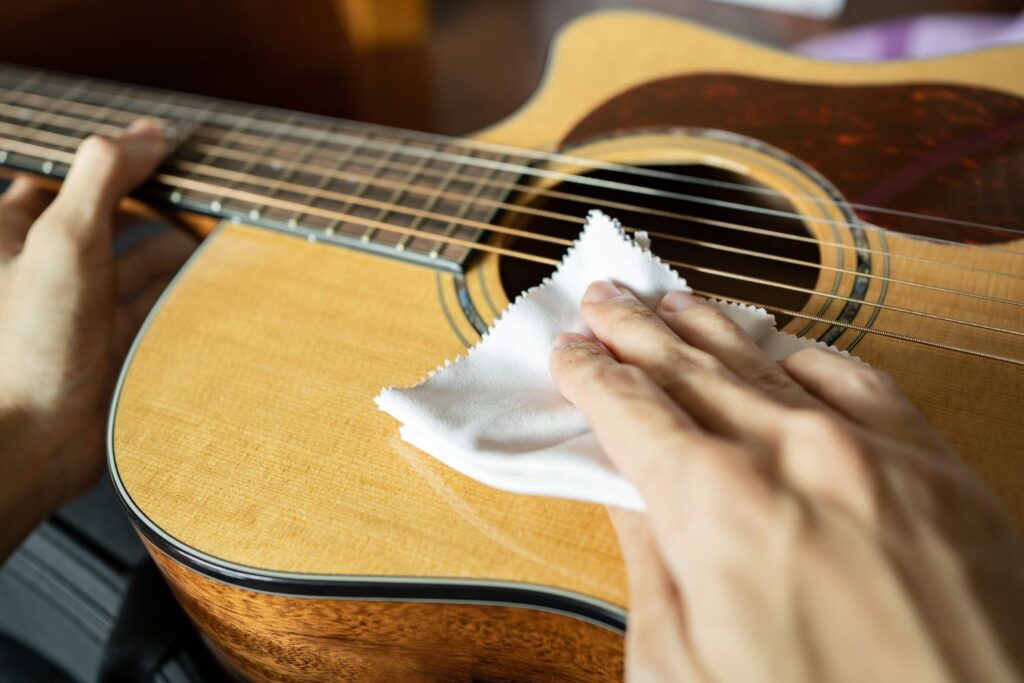
Wiping the guitar can help to remove any fingerprints and sweat that may have accumulated, which is important as these can cause the strings to rust and the body to discolor over time.
Aside from cleaning, the child should also learn to properly store the guitar when it is not in use.
The safest place to keep a guitar is in a case or a stand that is specifically built for guitars.
Leaving a guitar leaning against a wall or laying around on the floor can lead to physical damages such as scratches, chips, or worse, the neck bending.
Aside from external factors, the guitar’s temperature and humidity levels also play a significant role in its longevity.
A guitar should be stored in an area where the temperature and humidity are stable.
Exposure to extreme temperatures can cause the wood to warp, and too much humidity can lead to the growth of mold.
To prevent these issues, consider purchasing a humidity control system for the instrument if you live in a particularly dry or humid place.
It is also important to regularly tune the strings of the guitar as a part of routine maintenance.
Frequent tuning can ensure that the guitar remains sounding its best and can actually prolong the life of the strings.
While some young musicians may be capable of learning to tune the guitar themselves, others might require assistance from an adult or an electronic tuner.
Moving on, occasional inspections are also necessary to detect any wear and tear on the guitar.
It’s important to keep an eye out for any changes to the sound, playability, or physical appearance of the instrument.
If any serious problems are detected, it would be best to consult a professional luthier for repair or advice.
Lastly, teaching your child how to properly handle the guitar is an essential part of its care.
All these steps of cleaning, storing, controlling the environment, tuning, and inspecting constitute the proper maintenance of a kid’s acoustic guitar.
By taking the time to teach your child these methods, you can ensure the longevity and performance of the guitar, thereby enhancing their learning experience.
What Is the Difference Between a Kids Guitar and a Regular Size Guitar?
When choosing an acoustic guitar for your child, it’s important to understand that kids acoustic guitars are different from regular-sized guitars in a number of ways.
Firstly, size plays a critical role.
Kids guitars are scaled-down versions of regular guitars, designed to be easier for smaller hands to handle and play.
In general, kids guitars are approximately half the size of a standard guitar.
This allows young learners to comfortably reach the guitar’s frets and strings, encouraging proper technique from the very beginning.
Secondly, the materials used in kids guitars often differ from those used in full-sized guitars.
Many manufacturers use lighter-weight woods and other materials to make the guitar more manageable for a child to hold and play.
Reducing the weight of the instrument is particularly important for kids, as heavy guitars can cause physical discomfort, leading to a lack of focus and diminishing their enthusiasm for learning.
Another important difference is related to strings.
Many kids guitars are strung with nylon strings instead of the steel strings found on many adult guitars.
Nylon strings are softer on the fingers, making them a gentler choice for beginners, preventing sore fingers which can often discourage kids from practicing.
Lastly, kids guitars are often more brightly colored and feature fun designs to make the instrument more attractive and engaging for kids.
While the sound quality and playability might not be as sophisticated as a regular-sized guitar, the visual appeal can be a significant motivation for young learners to regularly pick up their instrument.
Despite these differences, it’s important to note that kids guitars are not mere toys.
Most are fully functional instruments designed to give children a proper introduction to the world of guitar playing.
They are intended to encourage kids’ interest in music, helping them build the necessary skills before transitioning to a full-size guitar.
By starting with a guitar appropriate for their age and size, kids are able to learn comfortably and effectively.
This way, when they grow older and move on to a regular sized guitar, they’ll be equipped with the essential knowledge and experience to excel.
Choosing the right kids guitar may seem challenging, but understanding these differences will help in making an informed decision that best suits your child’s needs and preferences.
Remember, the ideal instrument for any beginner, especially a child, is the one that encourages regular, enthusiastic practice.
Do Kids Outgrow These Guitars Quickly or Will They Last?
When it comes to guitars for kids, one widespread concern among parents is how long the instrument will last.
Typically, the lifespan of a kid’s guitar is largely dependent on the child’s growth rate and interest levels.
The primary factor is the size of the child and the size of the guitar.
As children grow quickly, their hands and arms will also grow, which can make a smaller guitar inefficient.
This may require upgrading the guitar to a larger size to better accommodate the kid’s growth.
Physical growth rate is a significant consideration, which cannot be overlooked.
Next, we should consider the child’s interest level in playing the guitar.
A child with a high level of interest in the guitar practice will most likely use the instrument more frequently.
This might lead to a greater wear and tear quicker than in a case where the guitar is seldom used.
Although high-quality guitars are designed to withstand this wear and tear over time, it can still affect the instrument’s lifespan if maintained improperly.
Therefore, for the guitar to last longer, proper care and maintenance are crucial.
The proper maintenance regime includes cleaning the guitar regularly, keeping it in a case when not in use, and changing the strings as needed.
Both the child’s physical growth and the proper care and maintenance of the guitar directly influence its lifespan.
On the other side, it’s essential to realize that upgrading a guitar is not necessarily a bad thing.
Usually, as a child progresses in their guitar learning journey, they will require a more sophisticated instrument that matches their advancing skills.
This natural progression can indeed be seen as a sign of success in the child’s musical journey rather than an inconvenience.
A higher quality guitar might also boost the child’s interest and motivation as they feel their progress and commitment are being acknowledged.
However, it is also feasible for a well-maintained kid’s guitar to serve several years and even pass down to younger siblings.
This often depends on the original quality of the guitar and the level of maintenance it received throughout its use.
Ultimately, the question of whether kids outgrow their guitars quickly or they will last for years is determined by a combination of factors, including the child’s physical growth, care and maintenance of the instrument, and progression in guitar skills.
Are There Any Recommended Guitar Education Programs for Kids?
Learning to play a musical instrument such as a guitar offers numerous benefits to children.
Not only does it help in their cognitive and physical development, but it also boosts their self-esteem.
As such, numerous guitar education programs have been developed specifically for kids.
These tailored programs focus on the unique learning methods and interests of children, thus ensuring that they stay engaged and thoroughly enjoy their musical journey.

A common misconception is that guitar learning needs to be face-to-face.
While this traditional way has its specialties, there are now many online guitar programs that are just as effective.
These online courses offer flexibility, allowing your child to learn at their own pace.
Also, children can practice anytime they want, as the lessons are pre-recorded or written.
Among the most recommended online guitar programs for children are JustinGuitar, JamPlay, and Guitar Tricks.
JustinGuitar is an all-ages course that includes guitar lessons designed specifically for kids.
Kids can slowly progress from the beginner to advanced levels in a fun and engaging way.
On the other hand, JamPlay offers online guitar courses that are gamified.
In this way, it makes guitar learning more entertaining, ensuring that kids don’t get bored but instead look forward to their next session.
As for Guitar Tricks, they offer a comprehensive course designed for kids as young as seven years old.
Each course is structured and easy to understand, making it ideal for kids with no previous musical background.
Apart from providing lessons, these programs also offer online support, further assisting your child in their guitar learning journey.
Another important aspect to consider when looking for a guitar education program for your child is the teaching methodology.
It’s crucial that the teachers know how to make learning enjoyable for kids.
The best programs incorporate songs, games, and other fun activities in their lessons to keep children engaged and motivated.
In addition, look for a program that values progress and not perfection.
Knowing that they are improving, regardless of how slow it might seem, helps boost a child’s confidence and interest in learning the guitar.
When it comes to the cost, the prices for these guitar courses vary.
Some offer a one-time payment for lifetime access while others opt for a monthly subscription plan.
While it might be tempting to go for the cheapest option, it’s vital to consider what each course offers and whether it aligns with your child’s interests and learning style.
To sum up, there are various guitar education programs available for kids, each with its own unique approach to teaching.
The best course is one that can keep your child enthusiastically engaged, helping them foster a love for music while progressing at their own convenient pace.
The Bottom Line
So, after all we’ve discussed, picking out the perfect acoustic guitar for your child is certainly no small task.
By focusing on the quality, size and ease of playing, you can ensure that you’re making a sound investment in your child’s musical journey.
The ‘Best Acoustic Guitars For Kids That They’ll Love’ that we’ve looked at today certainly hit these marks and more.
When it comes down to it, choosing the right guitar all boils down to the one that will inspire your child to play and will be inviting rather than intimidating.
We sincerely hope that our picks help and motivate your little future rock star on their exciting path.
In the end, the real winner is the guitar that brings out the widest smiles and the most cherished melodies.
Sources: sweetwater.com ; guitarcenter.com ; guitarworld.com ; killerguitarrigs.com

More than 10 years of experience playing and writing about guitars! When not writing, I can be found strumming away some Johnny Cash tunes. Favorite all time guitar is the Gibson Les Paul. #TeamGibson

